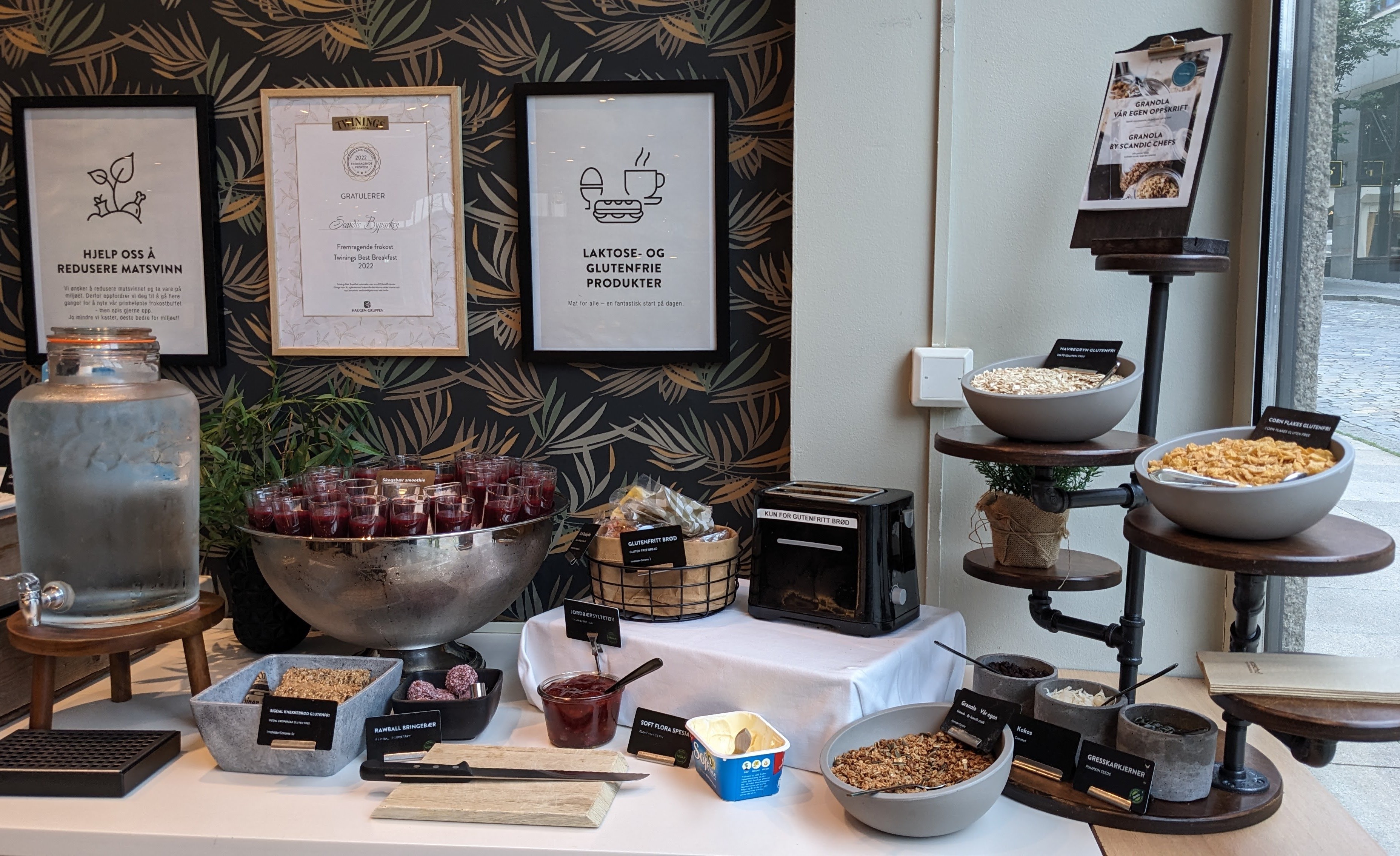
Breakfast bar included yogurt, muesli, and nuts

Lunch bar with cheeses and meats, plus lots of fresh fruit
The breakfast buffet at the Scandic Hotel was excellent. Because it offered sandwich-makings in addition to an array of cereals, fruit, and yogurt, we decided to pay the extra 85 kroner (about $8.50) the hotel was charging guests for the right to fill a take-away box so we could make lunches to eat later on the cruise ship.
Before the cruise we had to take another ride on the Bergensbanen, retracing the last hour and a half of the previous day’s railway journey. Heading east from Bergen, we followed the shore of Veafjorden (more of a North Sea strait than a fjord), passed through the village of Stanghelle, and disembarked in Voss, where we finally saw a ski resort. Being July, there was too little snow for skiing, but we recognized the accoutrements of a resort town: a gondola, nice hotels and cafés, and a big concert venue. (A thirteenth-century parish church reminded us that we weren’t in Park City or Vail.) Almost 150 other Norway-in-a-Nutshell travelers descended from the train with us and walked across the street to the bus station, where we queued up to board one of the four tour buses bound for Gudvangen, gateway to the Nærøyfjorden World Heritage Park. We were sorry that we didn’t have an extra day to stay and hike through the green hills around Voss, but even more picturesque areas awaited us.
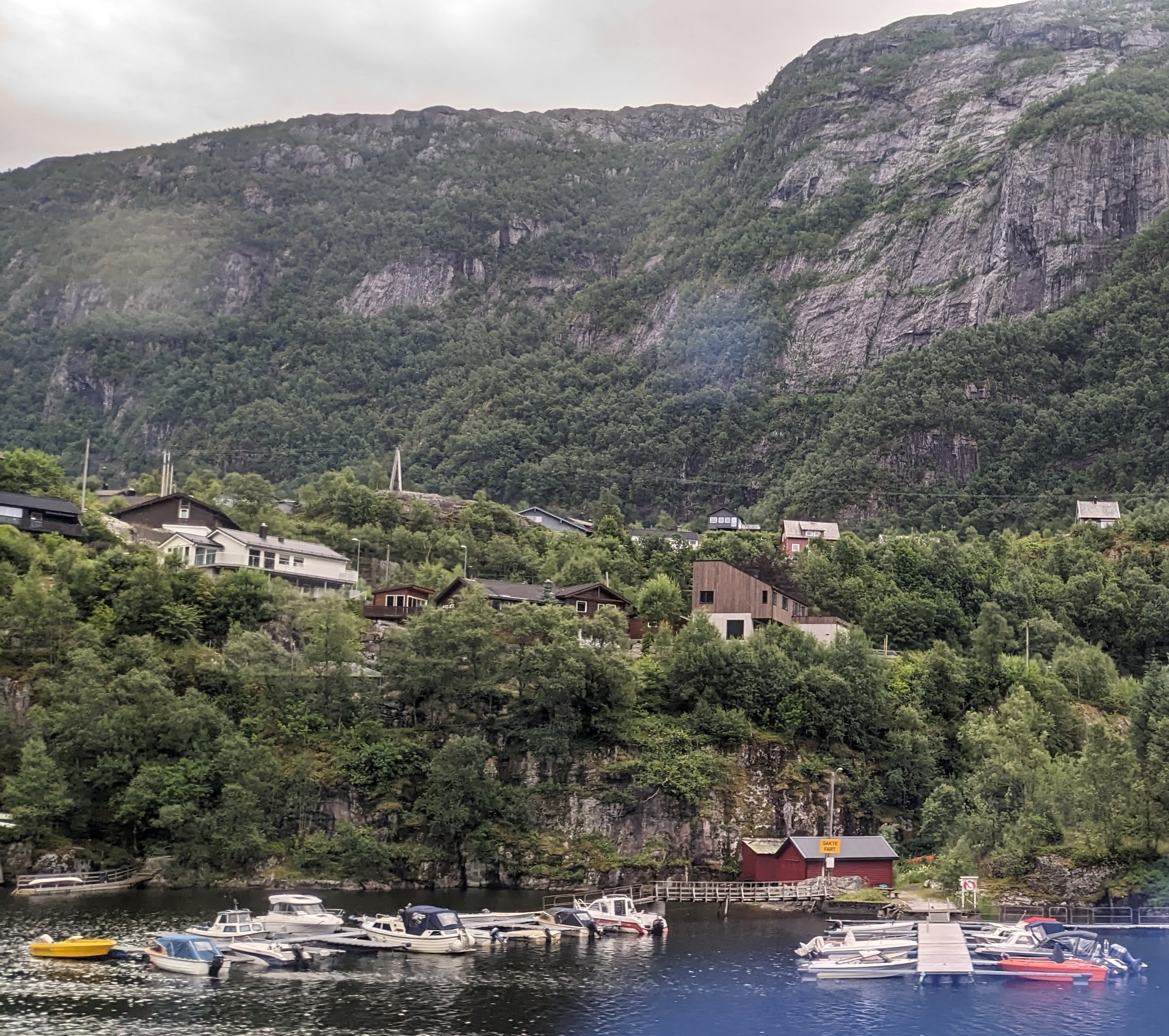 Stanghelle |
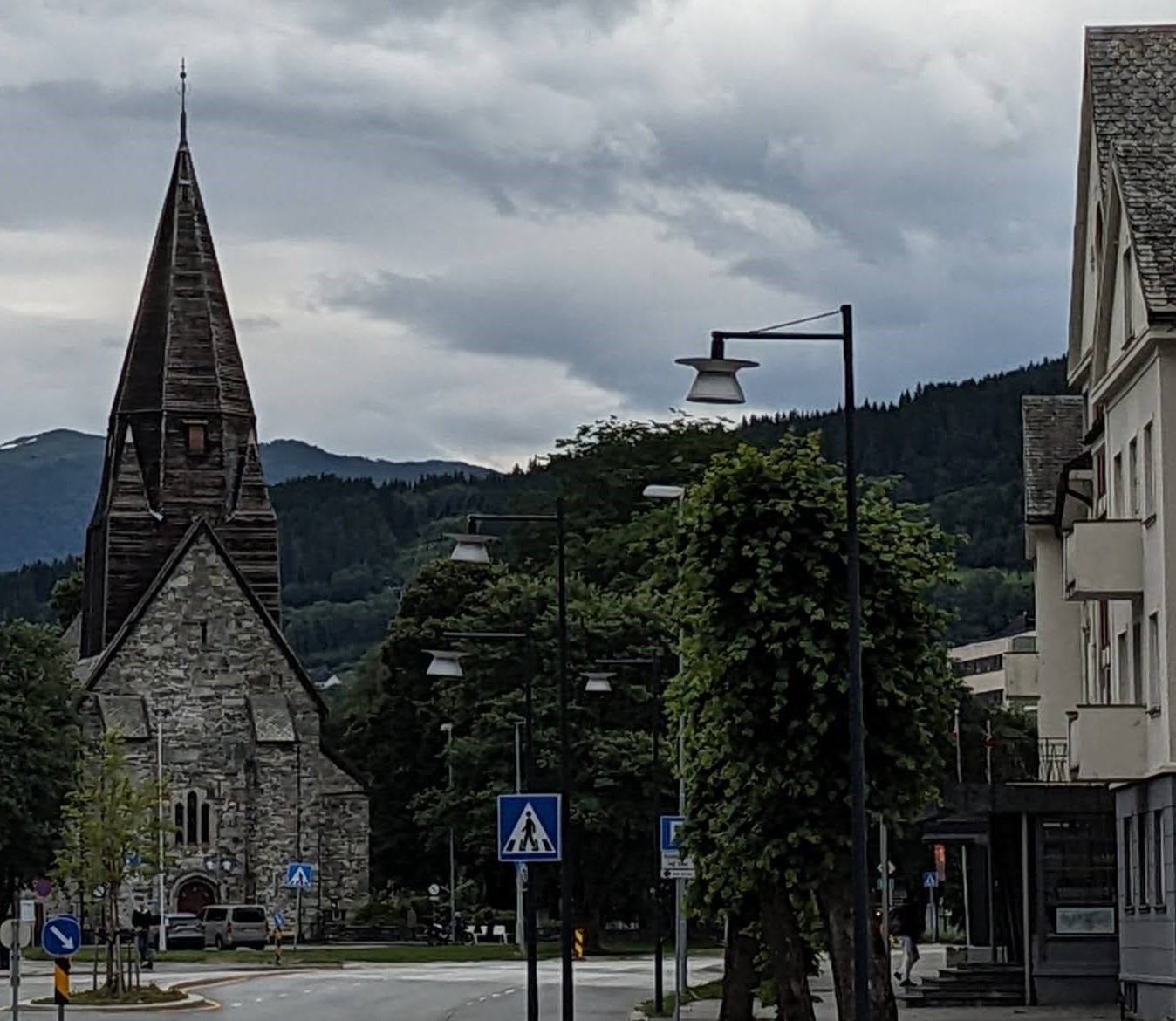 Voss Vangdkyrkja |
 Voss Cultural Center |
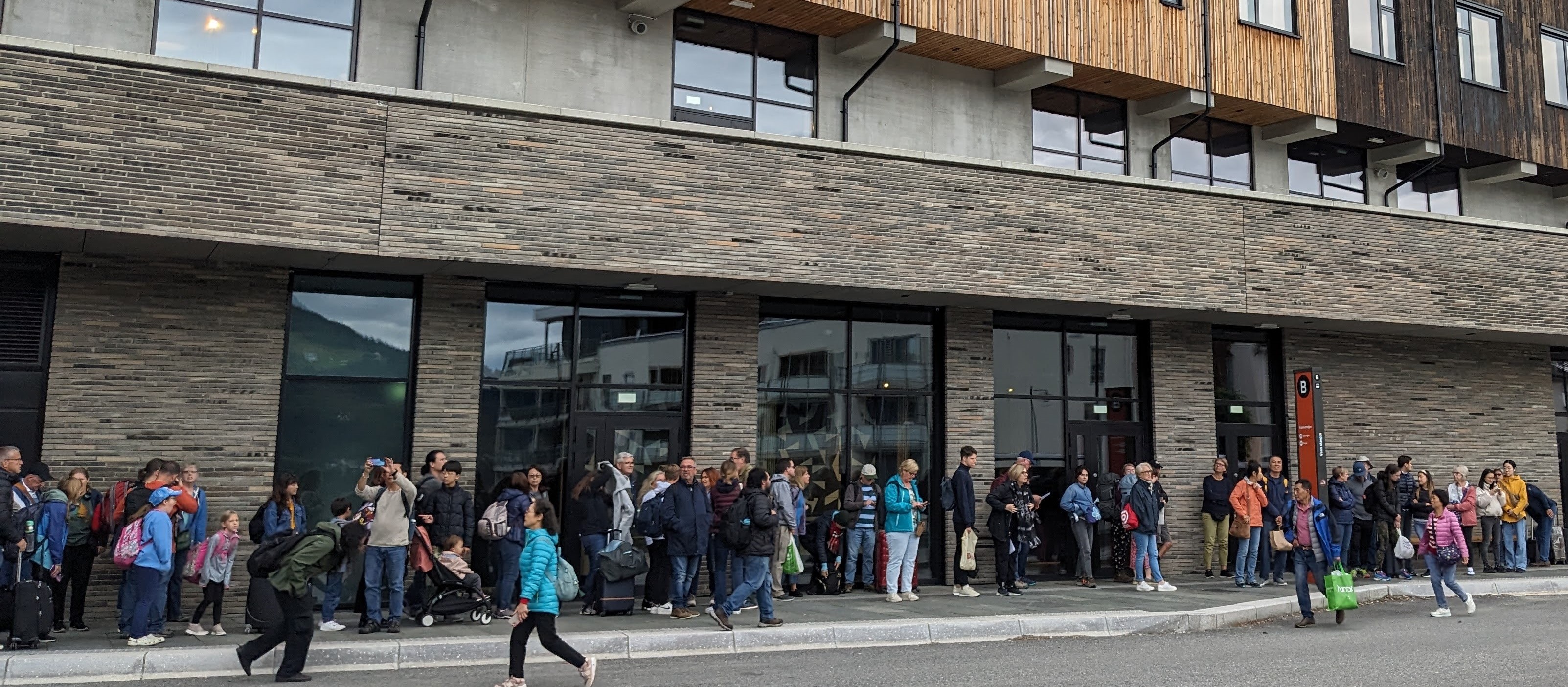 Waiting for the buses in Voss |
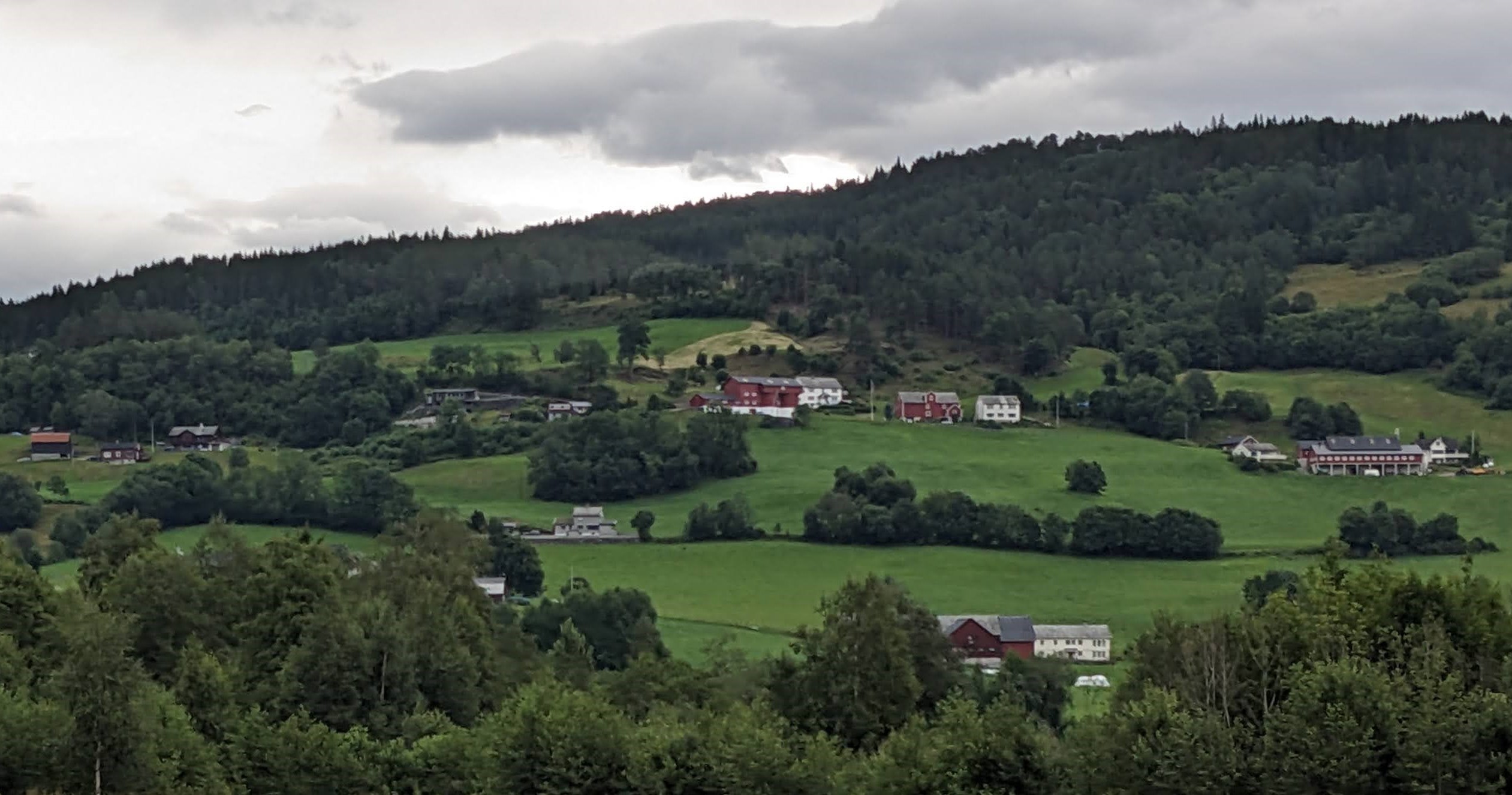 Rural Voss |
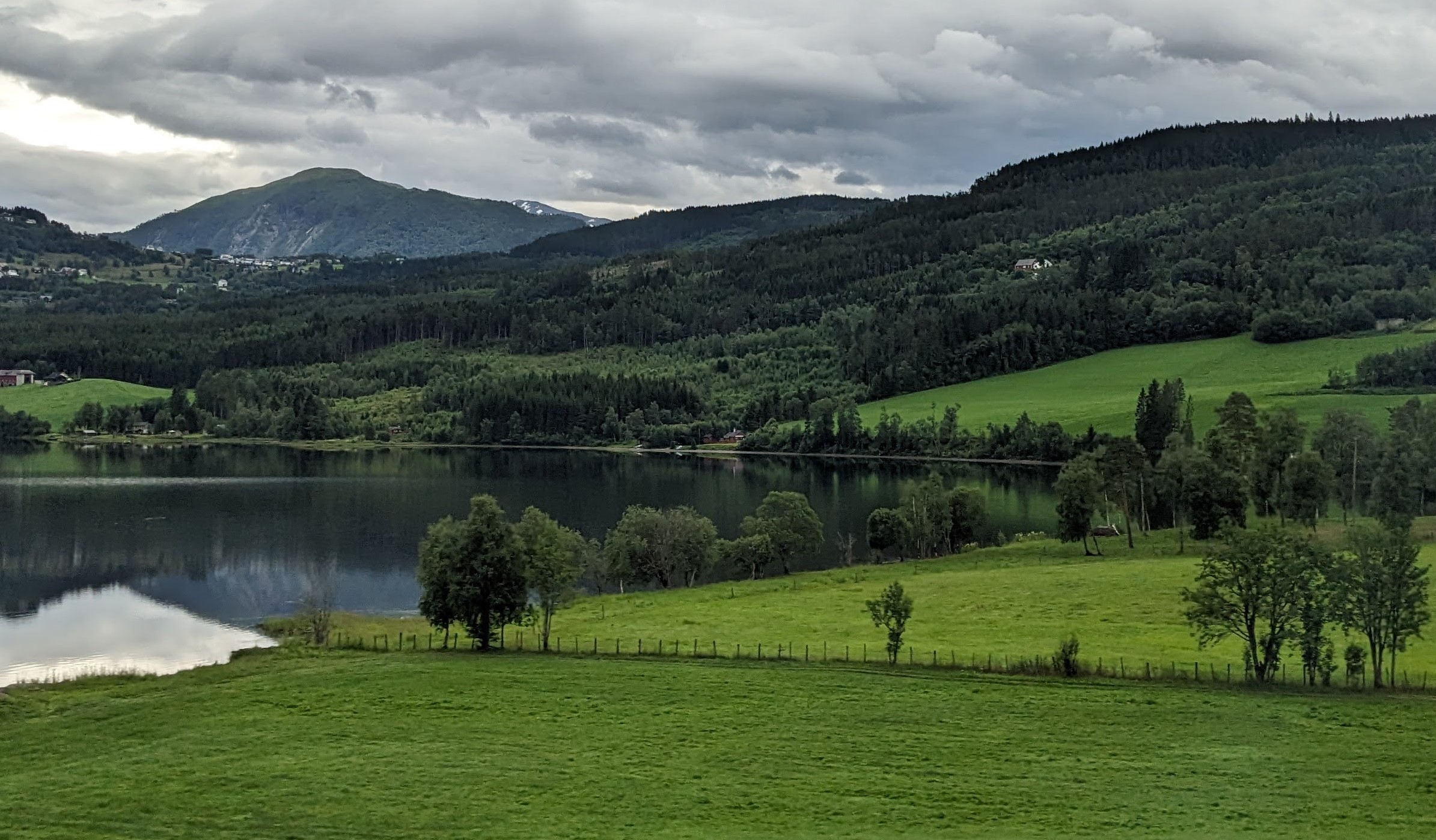 Skulestadmo |
About halfway to Gudvangen, the buses stopped at the historic Stalheim Hotel. In 1647, Stalheim became one of the stations along a new overland mail route between Oslo (then called Christiania after the Danish kings who ruled both Denmark and Norway) and the port of Bergen. As other travelers began following the post road—perhaps drawn by the spectacular scenery—local farmers supplied them with food and a place to sleep. Eventually an inn and then a luxury hotel were established on a hill overlooking the Nærøy River Valley. Some rooms on the main floor of the hotel showcase antiques from its three-hundred-year history.
Pat was grateful that the shop inside the Stalheim Hotel sold socks. Packing as light as possible for a trip to Europe in July, she hadn’t considered the idea that some places we planned to visit in Norway might not be as warm as those in France, so the only shoes she brought from the U.S. were sandals. “I knew we would be doing a lot of walking,” she explained, “and these are the most comfortable walking shoes I own!” But once we got into the mountains her bare toes started sending chills all the way up her legs, so she solved the problem with a pair of thick woolen socks.
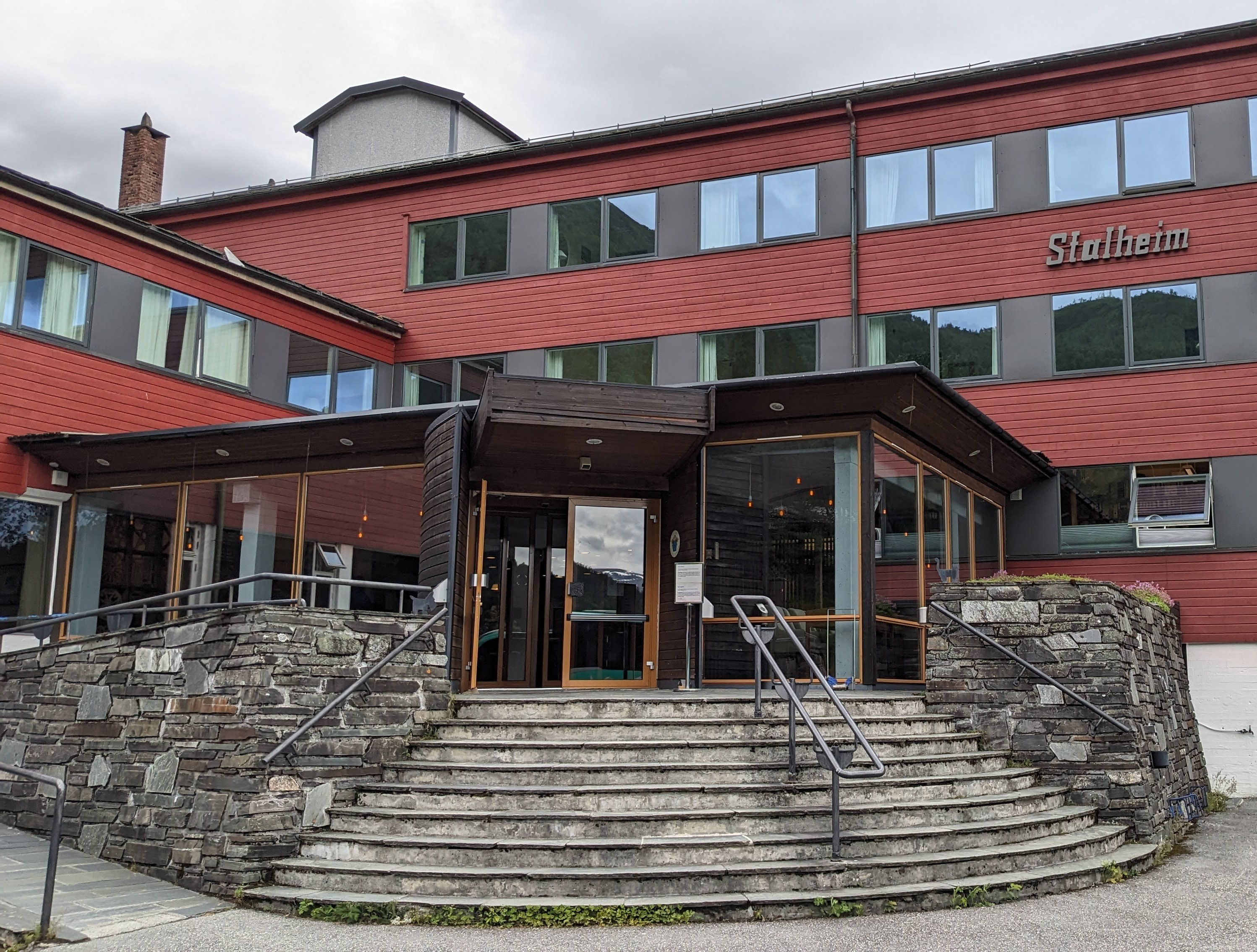 Stalheim Hotel |
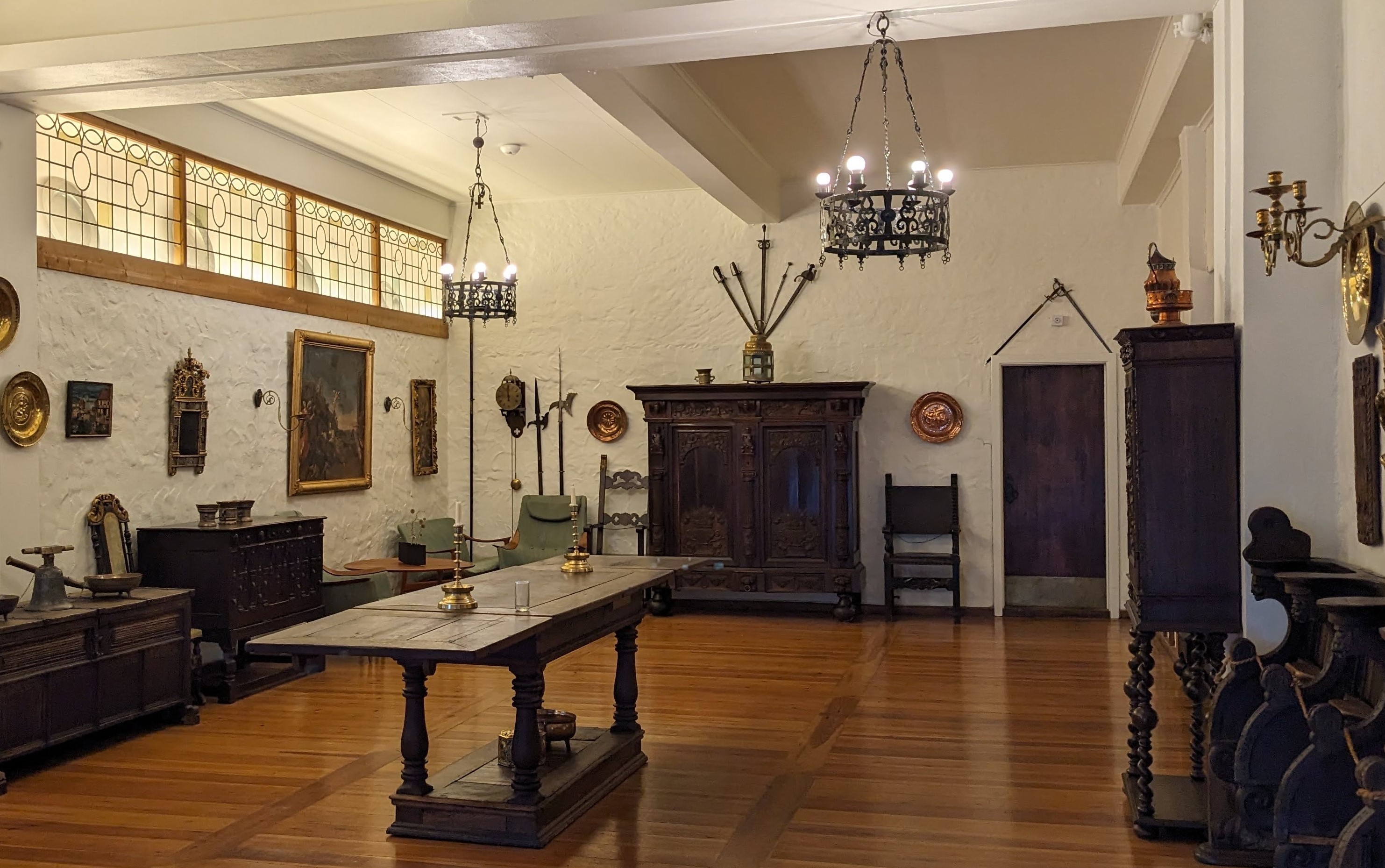 Antiques from the hotel’s storied past |
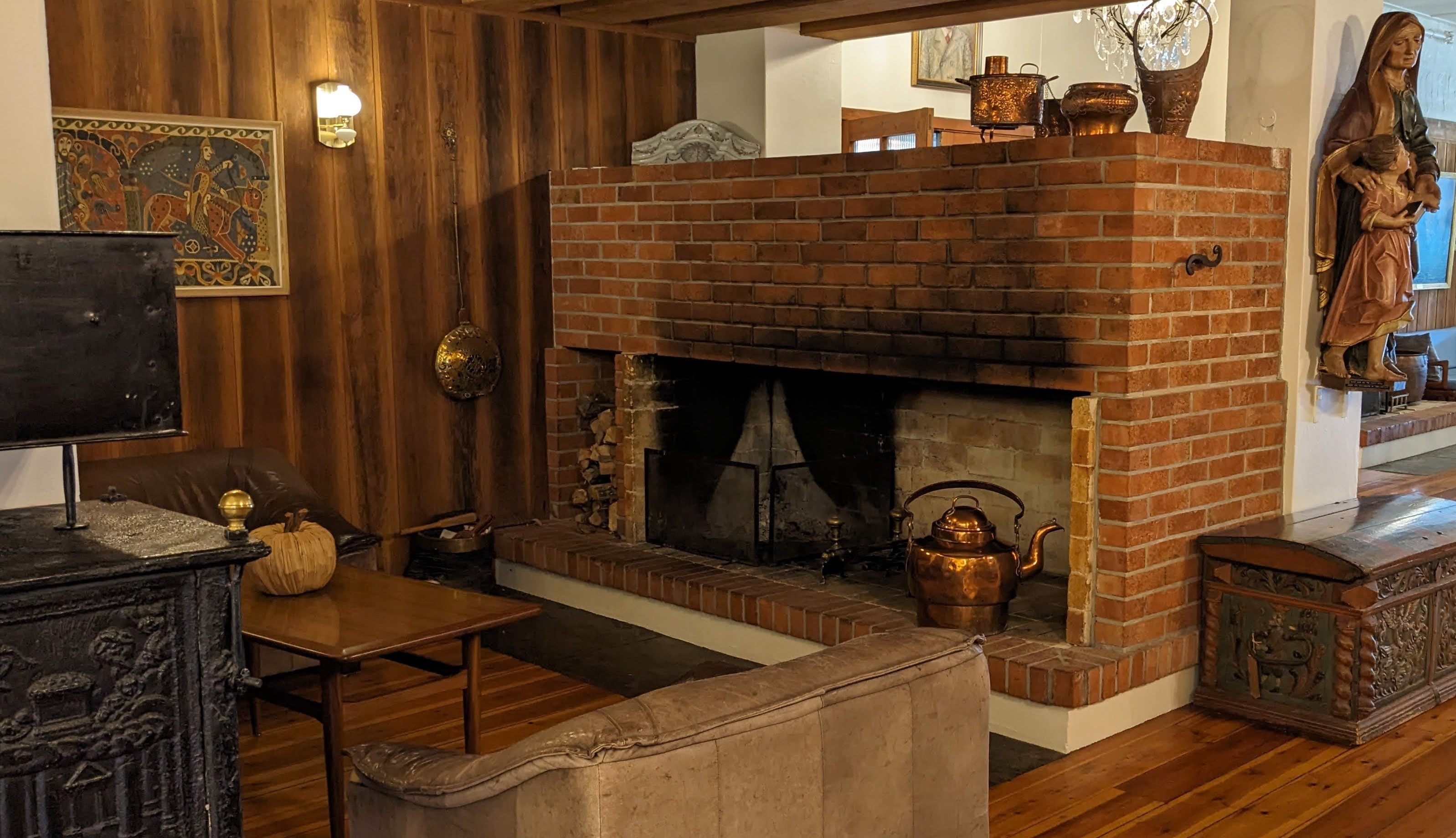 More antiques surround a hearth in the hotel |
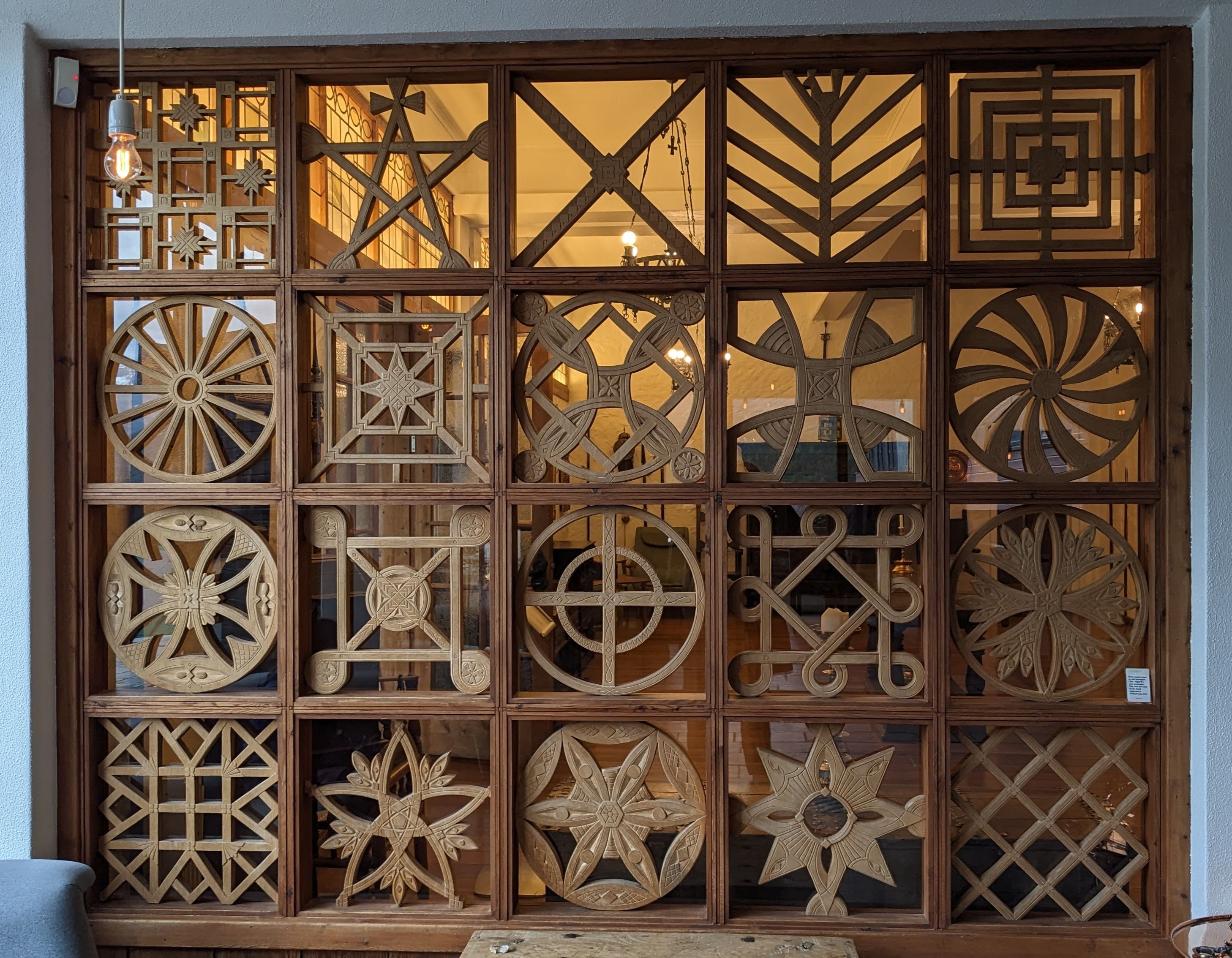 A screen made of carved Norse-Viking symbols divides a room |
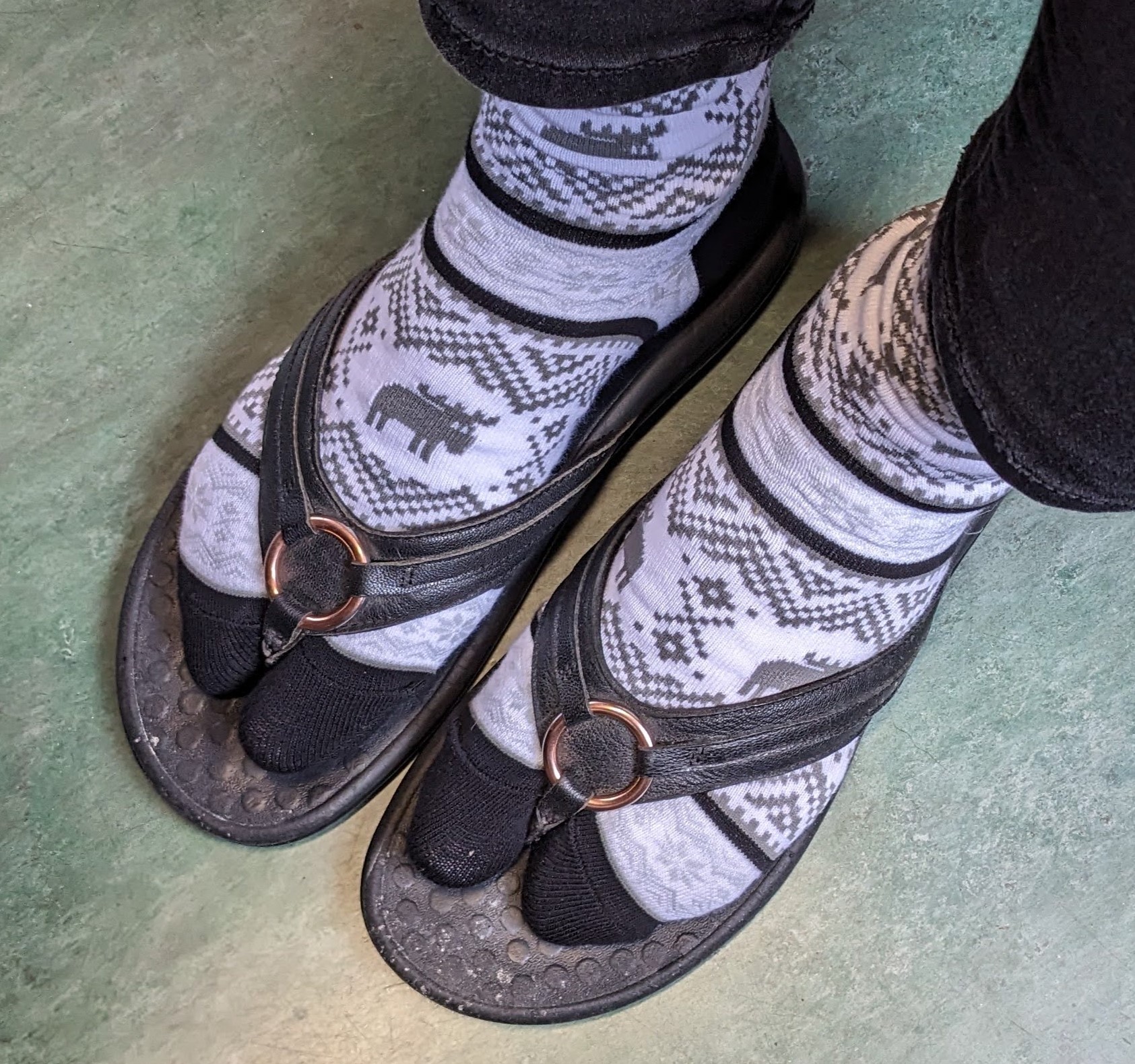 Pat’s Nordic socks |
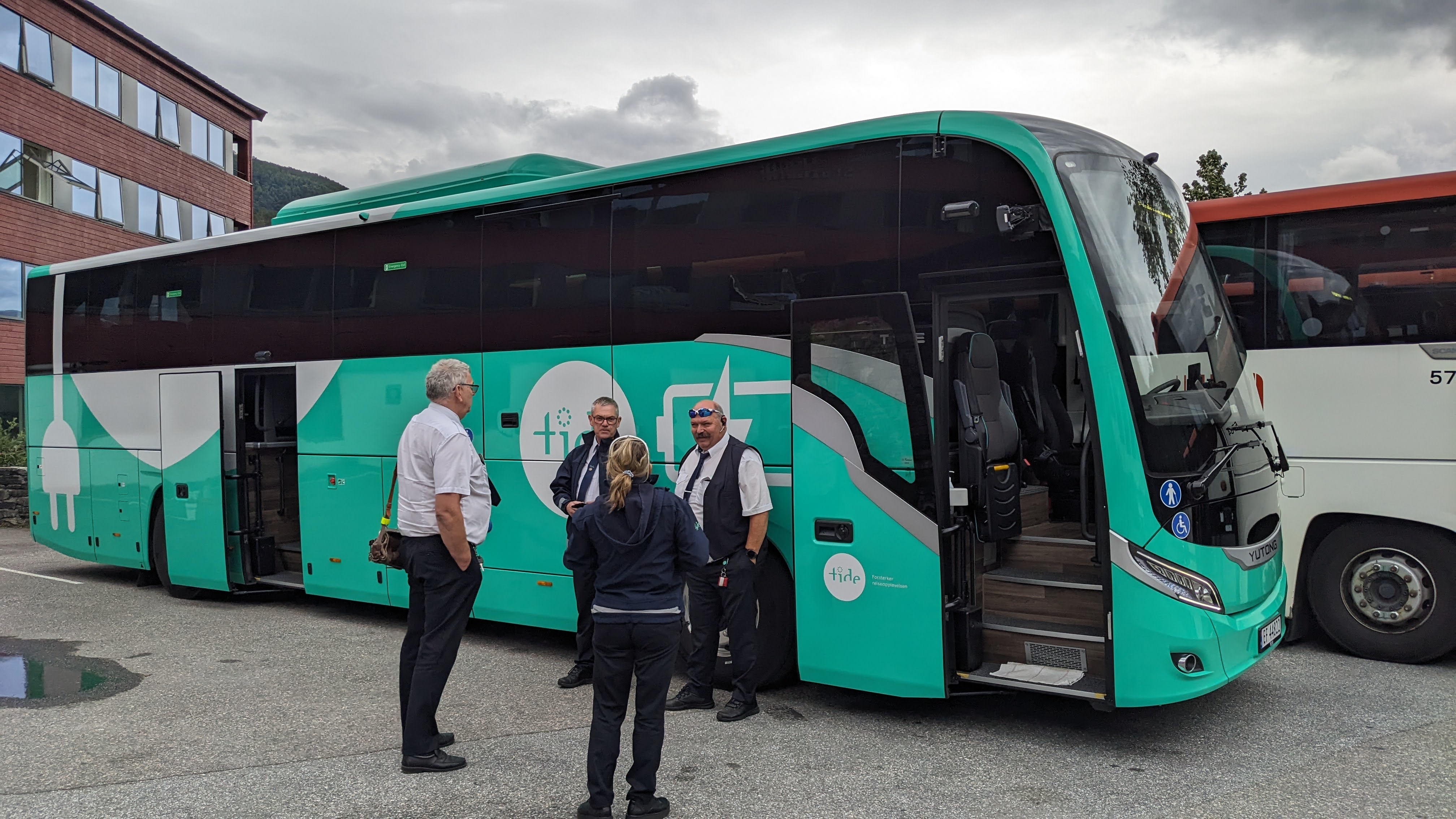 Our drivers wait while we explore the hotel |
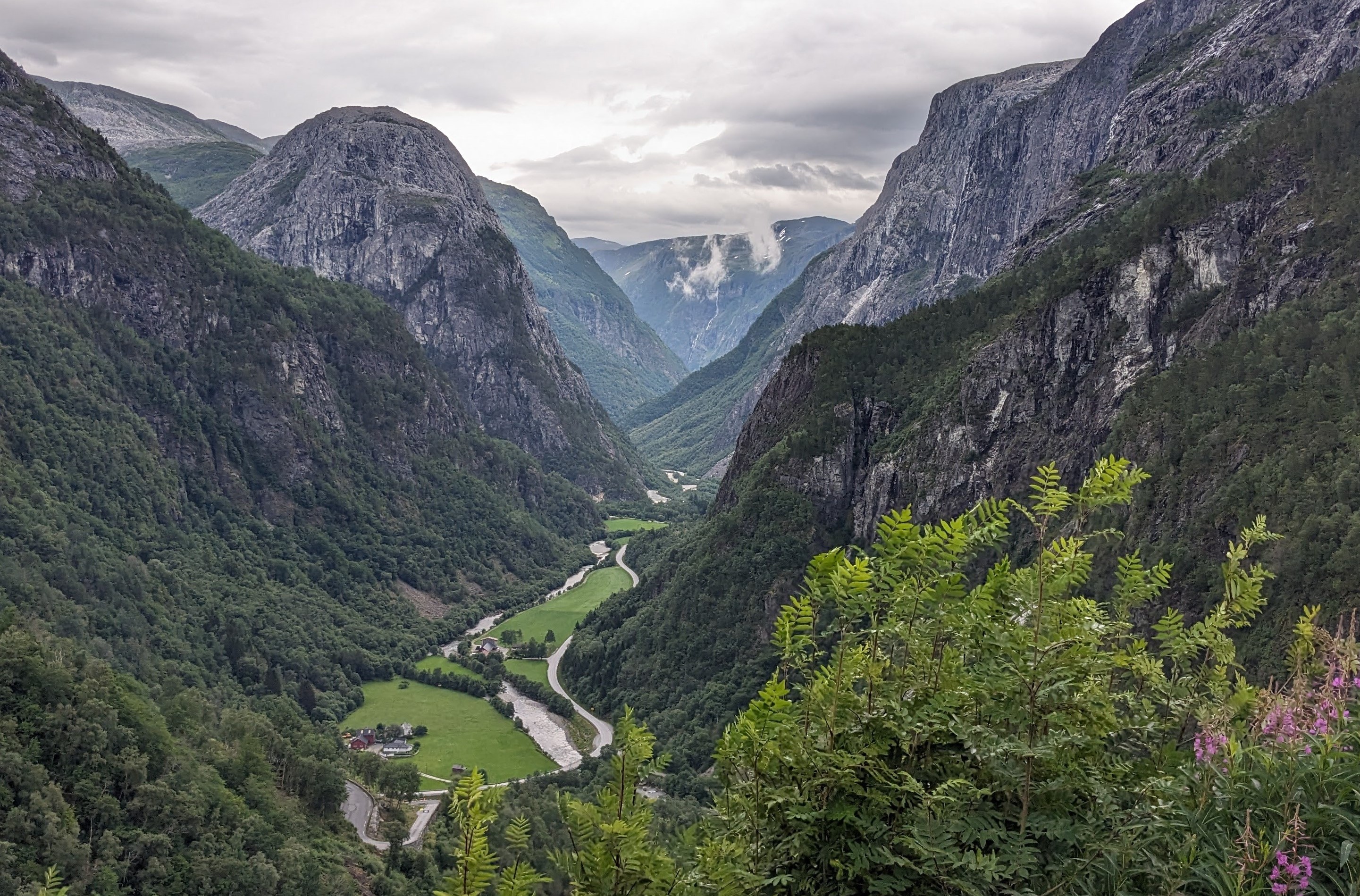
View of the Nærøy River Valley from Stalheim
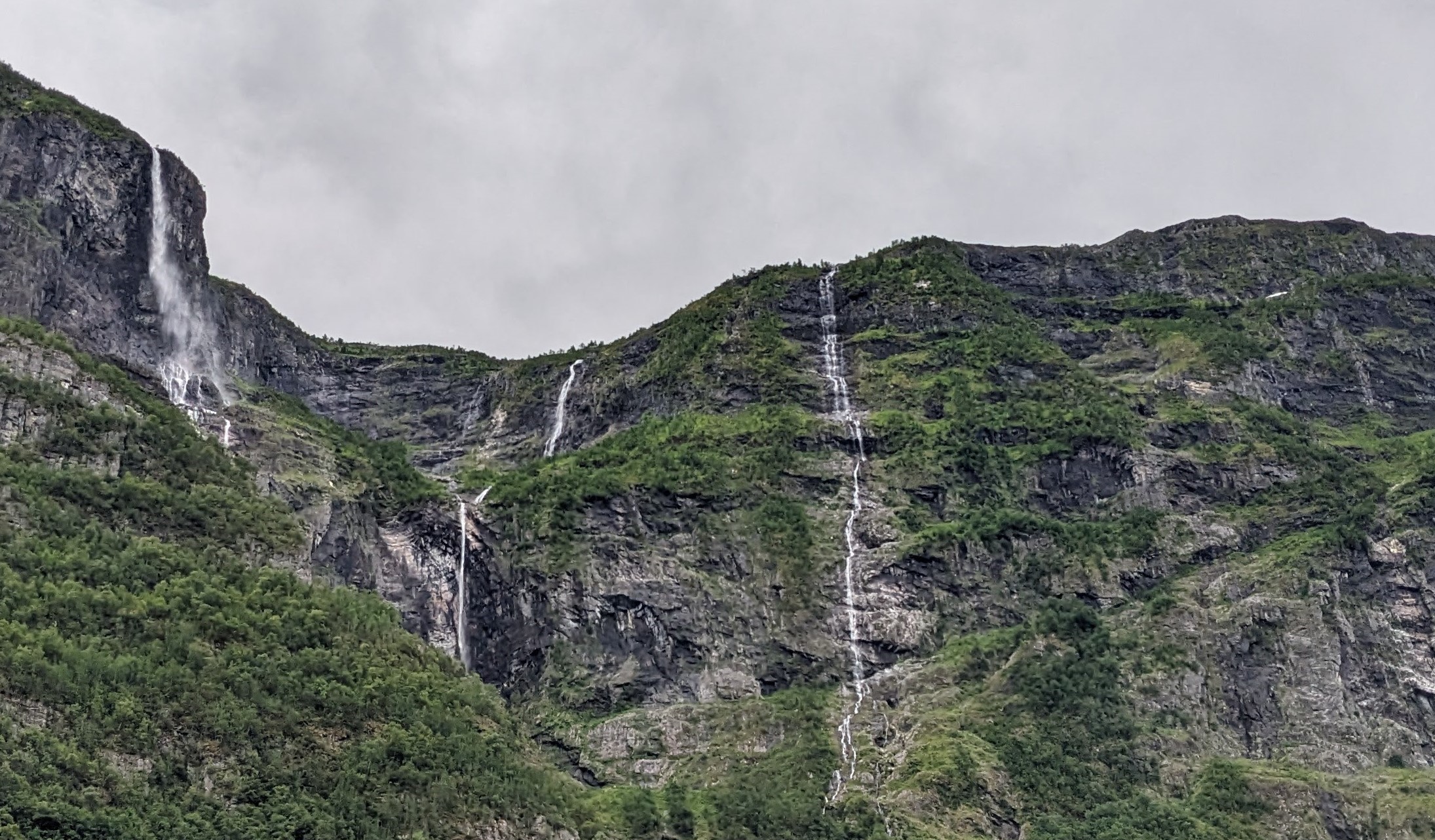
Waterfalls outside Gudvangen
At Gudvangen, we boarded the all-electric cruise ship that would take us up Nærøyfjord and down Aurlandsfjord. These are relatively small fjords, branches of the much larger Sognefjord that extends more than 200 kilometers (125 miles) inland from the North Sea. In this region, the land is so riven with fingers of water that it’s hard to determine whether one is on the mainland or on an island. According to several websites catering to tourists, the scenic terrain and quaint villages around Nærøyfjord and Aurlandsfjord inspired Disney’s designs for Arendelle, Elsa and Anna’s fictional kingdom in Frozen.

“Future of the Fjords” all-electric cruise ship
As we stood in line to get on the ship, we noticed a sign indicating that bringing food or drink onboard was prohibited, so we quickly stuffed our boxed lunches into our bags and hoped no one would notice. (Fortunately, there was no security check.) The best seats, at tables around the perimeter next to the windows, were already claimed, so we took the next best available seating in the first row of the bow and settled in for the ride. We soon noticed that although a lot of people had lined up to get something to eat from the snack bar, several others were pulling sandwiches and drink bottles from their own bags, so we did the same without worrying about getting reprimanded by the crew. (Nancy calculated that the lunch we had brought from the hotel cost about 40 percent less than the equivalent from the snack bar.)
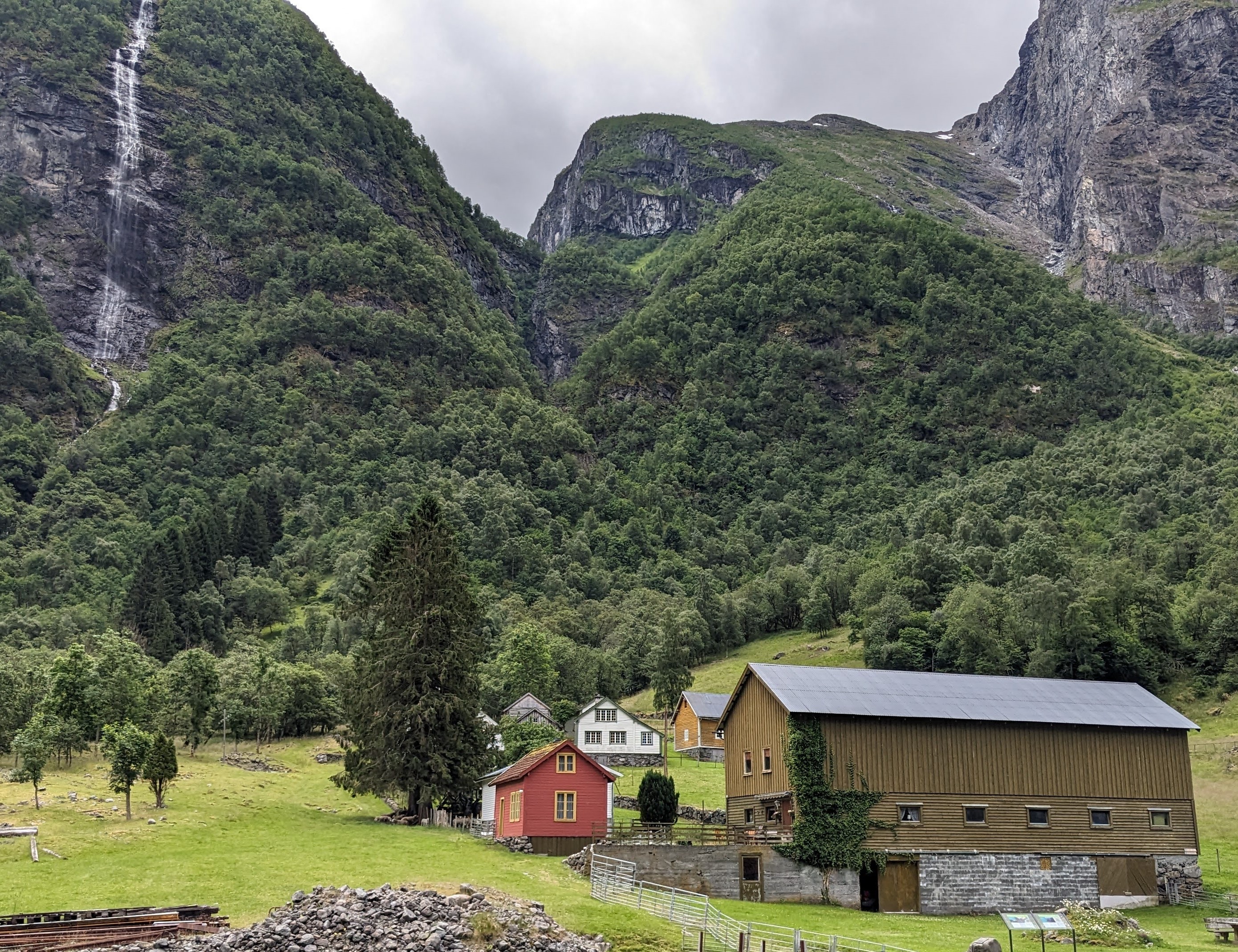
Styvi
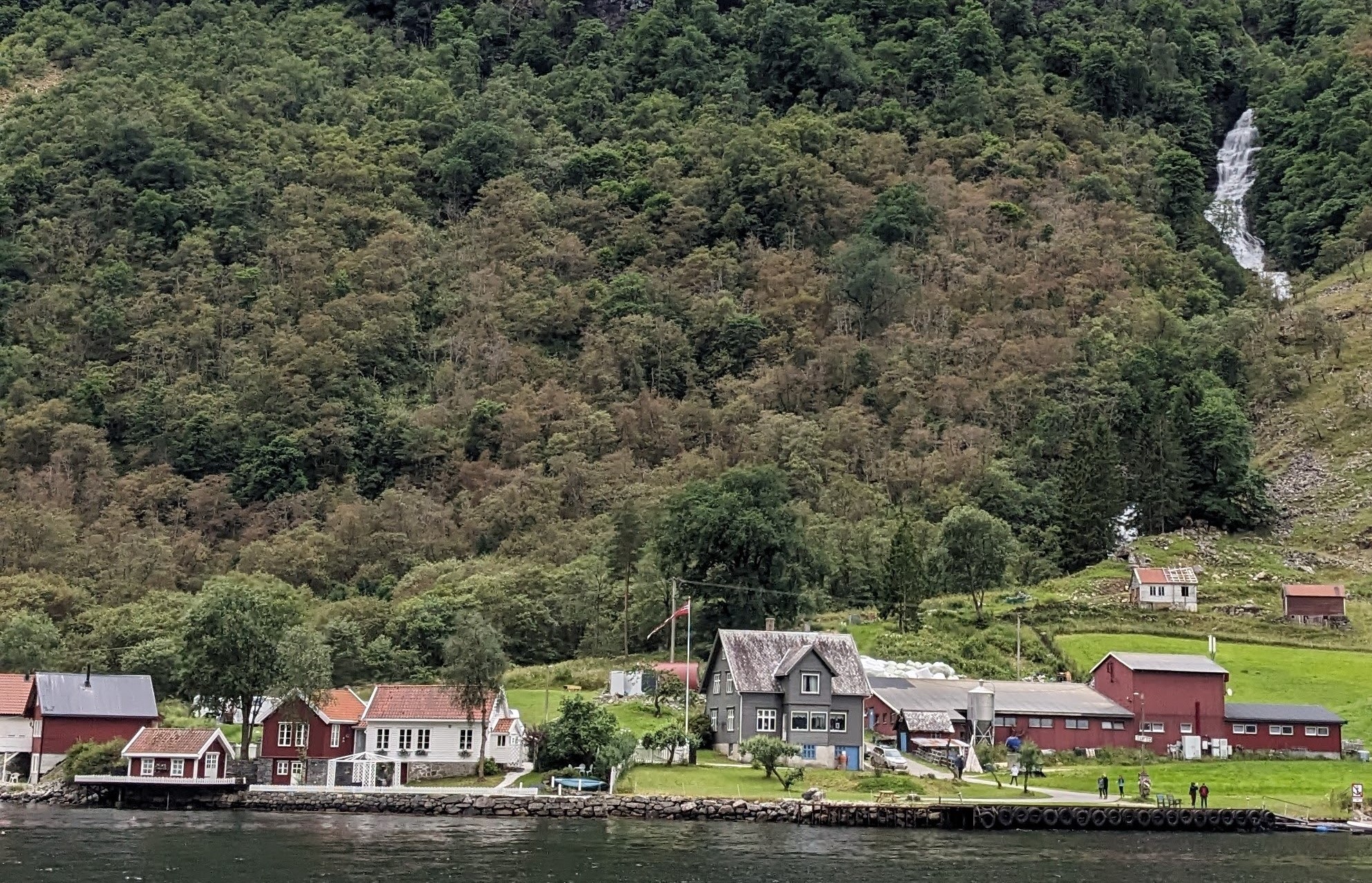
Bakka
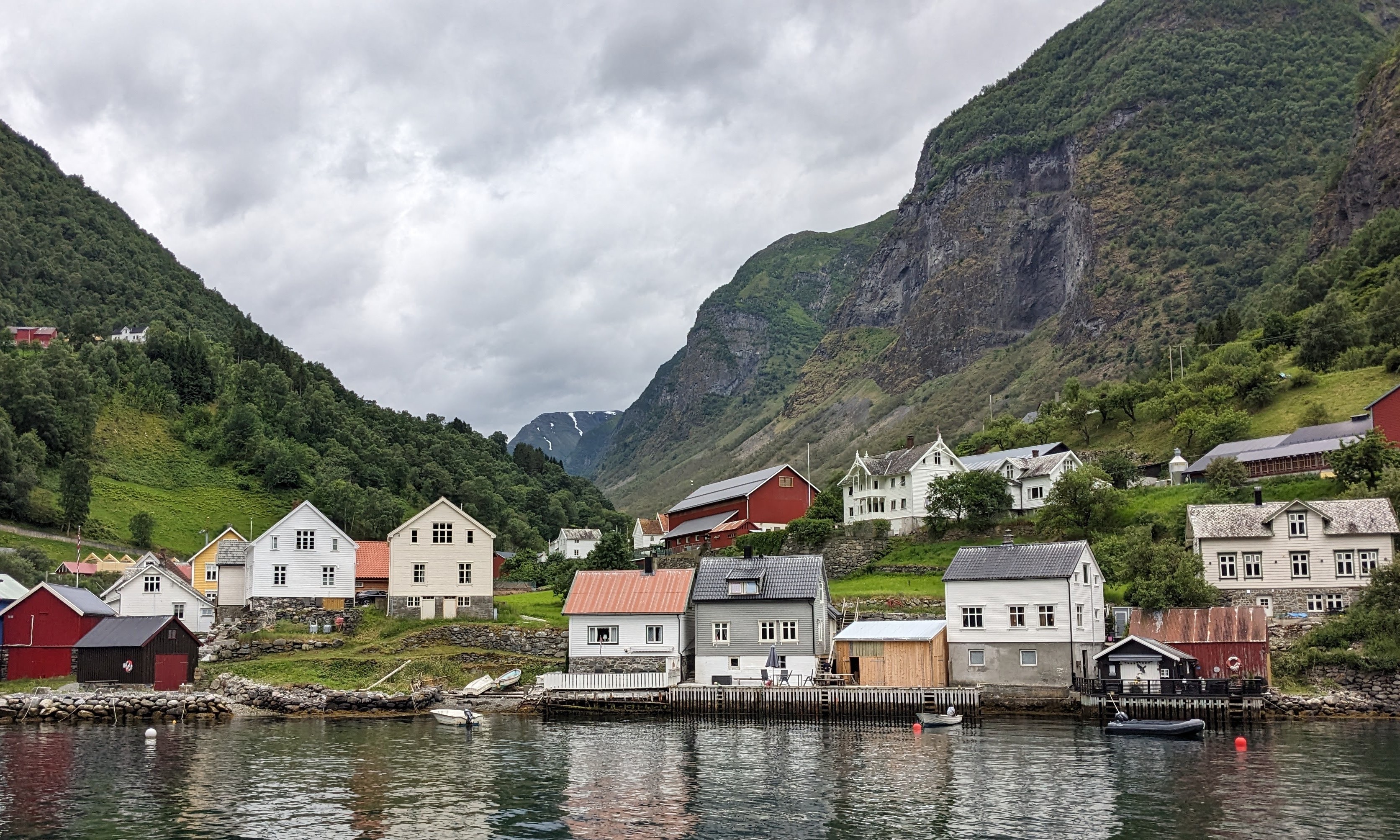
Undredal, where goats outnumber human residents 7:1
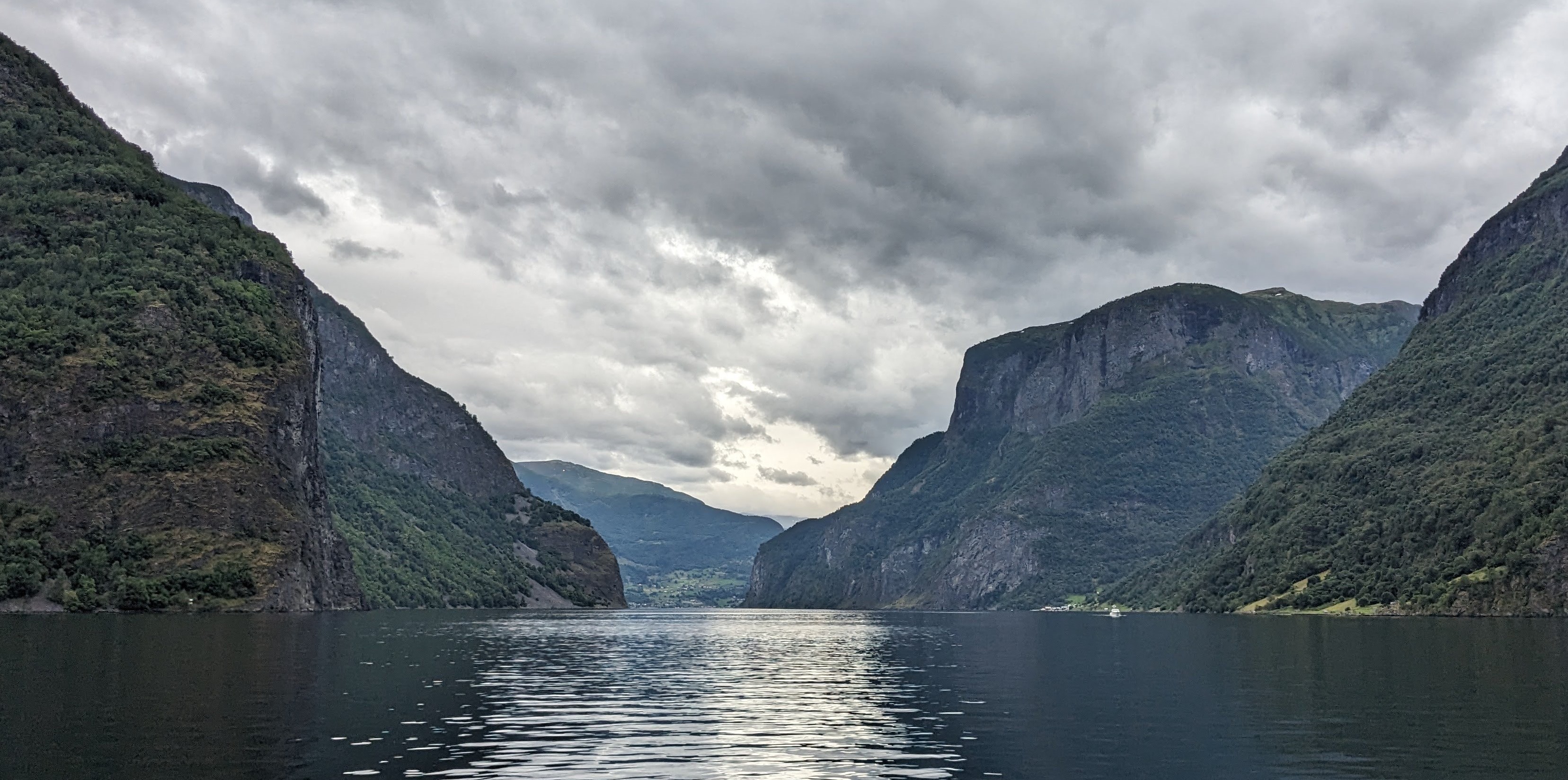
Sognefjord
We didn’t spend much time out on deck because even though it wasn’t too cold, it was windy and threatening rain. Unlike other tour-boat excursions we’ve taken, this one offered no onboard commentary from a guide, nor even any recorded narration. The only information provided to enrich our cruise experience came from a small monitor near the doors to the deck that displayed pictures and text, but the text was too small to read unless you were standing right next to it, and even then it flashed by so fast that you could never take it all in before the screen changed. Nancy finally decided to snap photos of each screen and then enlarged the text on her phone so we could read about points of interest along our route. In this way, we learned that the picturesque village of Undredal has only 50 permanent human residents but over 350 goats, which together produce more than ten tons of cheese every year. Undredal’s best known product is ekte geitost (“true goat cheese”), made by boiling goat’s milk and whey until the liquid has evaporated and the mixture has turned golden brown and the sugars in the milk have caramelized. (Sadly, we didn’t get to stop in the village, and never had a chance to sample any ekte geitost.)
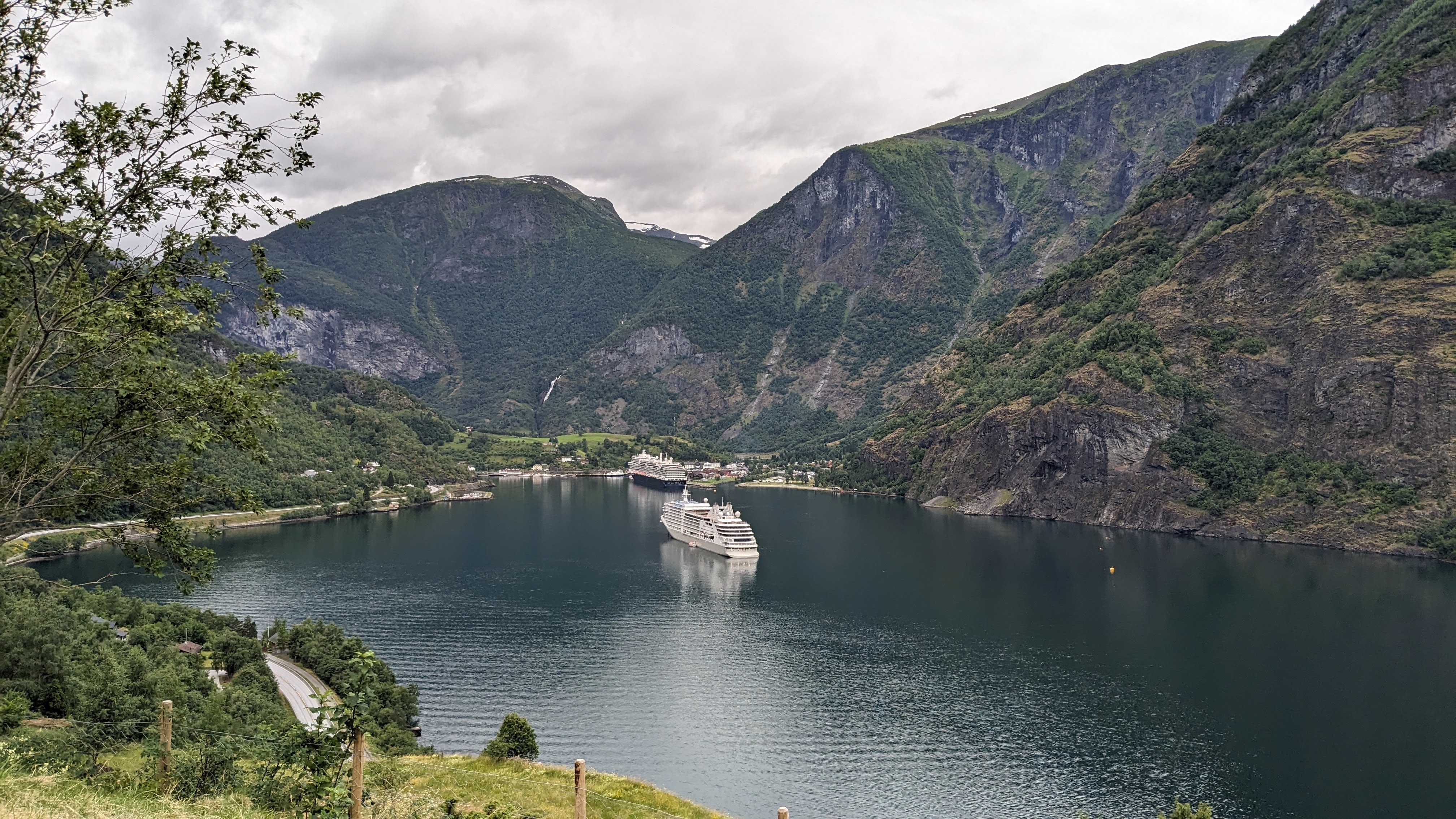
Another cruise ship entering Flåm
By the time we got to Flåm at the southern tip of Aurlandsfjord, it had started to rain lightly. We would have two hours in the village before catching the Flåmsbana (Flåm Railway) for the next segment of our Nutshell journey, but other than a railroad museum that none of us were keen to visit, it didn’t seem that Flåm offered much to do for two hours on a rainy day. However, Nancy had read about a historic farm community called Otternes Bygdetun only 6 kilometers (3.75 miles) away that sounded interesting. According to Tripadvisor, it offered tours of old farm buildings, demonstrations of traditional handicrafts, and samples of local farm fare, promising “an amazing trip back into the history and culture” of eighteenth-century Norway.
It sounded perfect to Nancy, but Michael wasn’t convinced that going to Otternes would be a good idea. “We won’t have enough time,” he said. “And how are we going to get there? It’s too far to walk.”
“I have no idea,” Nancy replied, “but there’s probably some sort of shuttle service. And what else are we going to do?”
Once we had disembarked in Flåm and walked into the visitors’ center, however, we looked in vain for any kind of transportation to Otternes Bygdetun; indeed, we didn’t see anything at all about Otternes Bygdetun, which seemed odd for a local tourist attraction that had been given 4.5 stars on Tripadvisor. Nevertheless, Nancy was undeterred. “We can hire a taxi,” she said, and headed for the parking lot behind the train station to find one.
The taxi driver, a Polish guy who had immigrated to Norway several years earlier, agreed to take us to Otternes, pick us up an hour later, and then drop us back off at the train station in Flåm by 3:45 p.m. The unpaved drive into the historic community was blocked by a locked gate at the bottom of the hill, so the taxi dropped us off there and we walked the rest of the way. We soon discovered why we had not seen or heard anything about Otternes Bygdetun at the visitors’ center in Flåm: not only was nothing in the historic village open, but it looked as though the site had been completely abandoned as a tourist attraction—possibly for years. (Looking back at the Tripadvisor listing later, Nancy realized that the last positive reviews for Otternes had been posted in 2016.) By this time the taxi had disappeared, of course, so we wandered among the deserted, empty buildings, admired the view of Aurlandsfjord below, and tried to get close enough to a cluster of grazing goats to take pictures without scaring the animals away.
Otternes Bygdetun
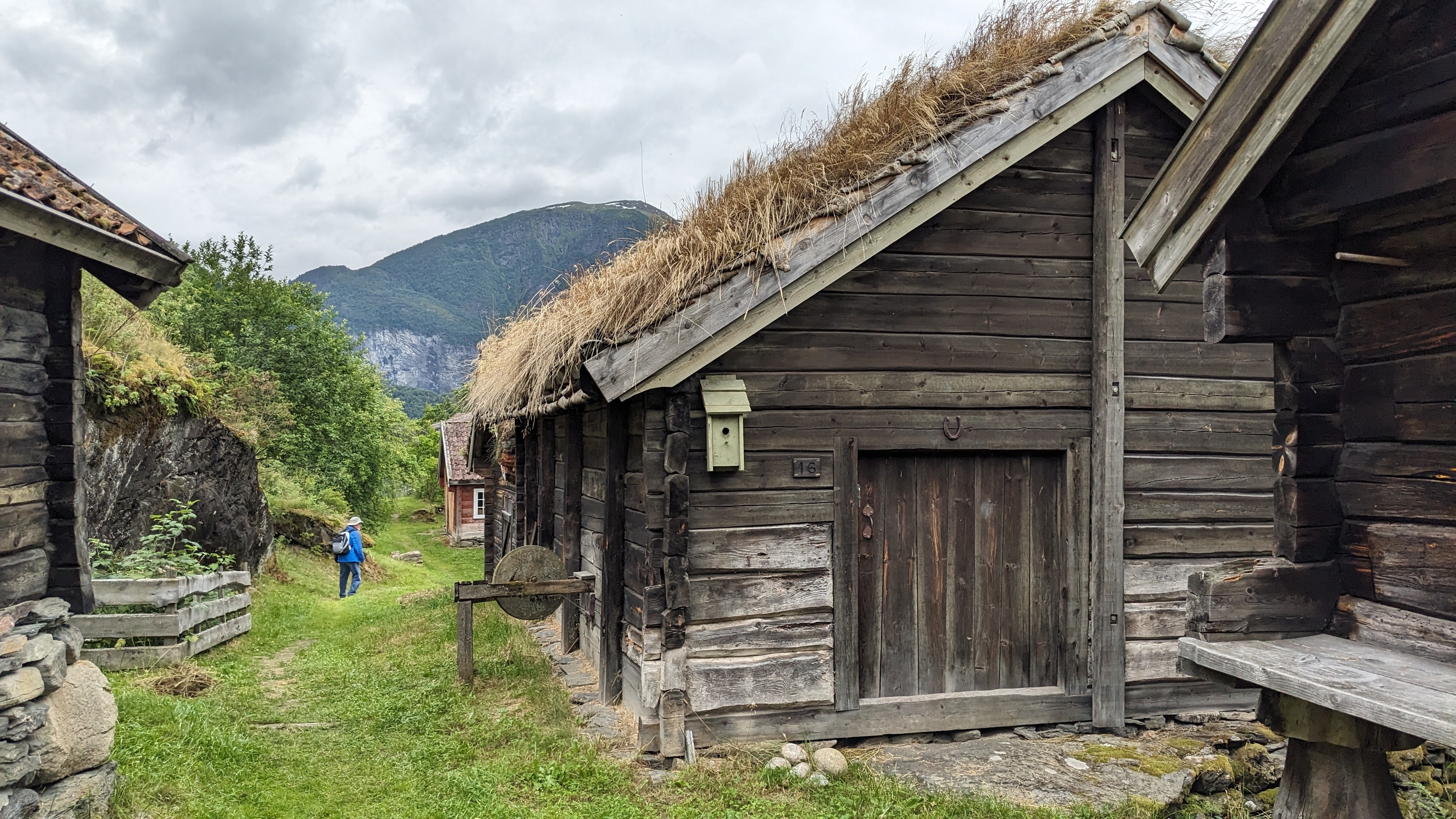 Michaek wanders among the abandoned farm buildings in Otternes Bygdetun |
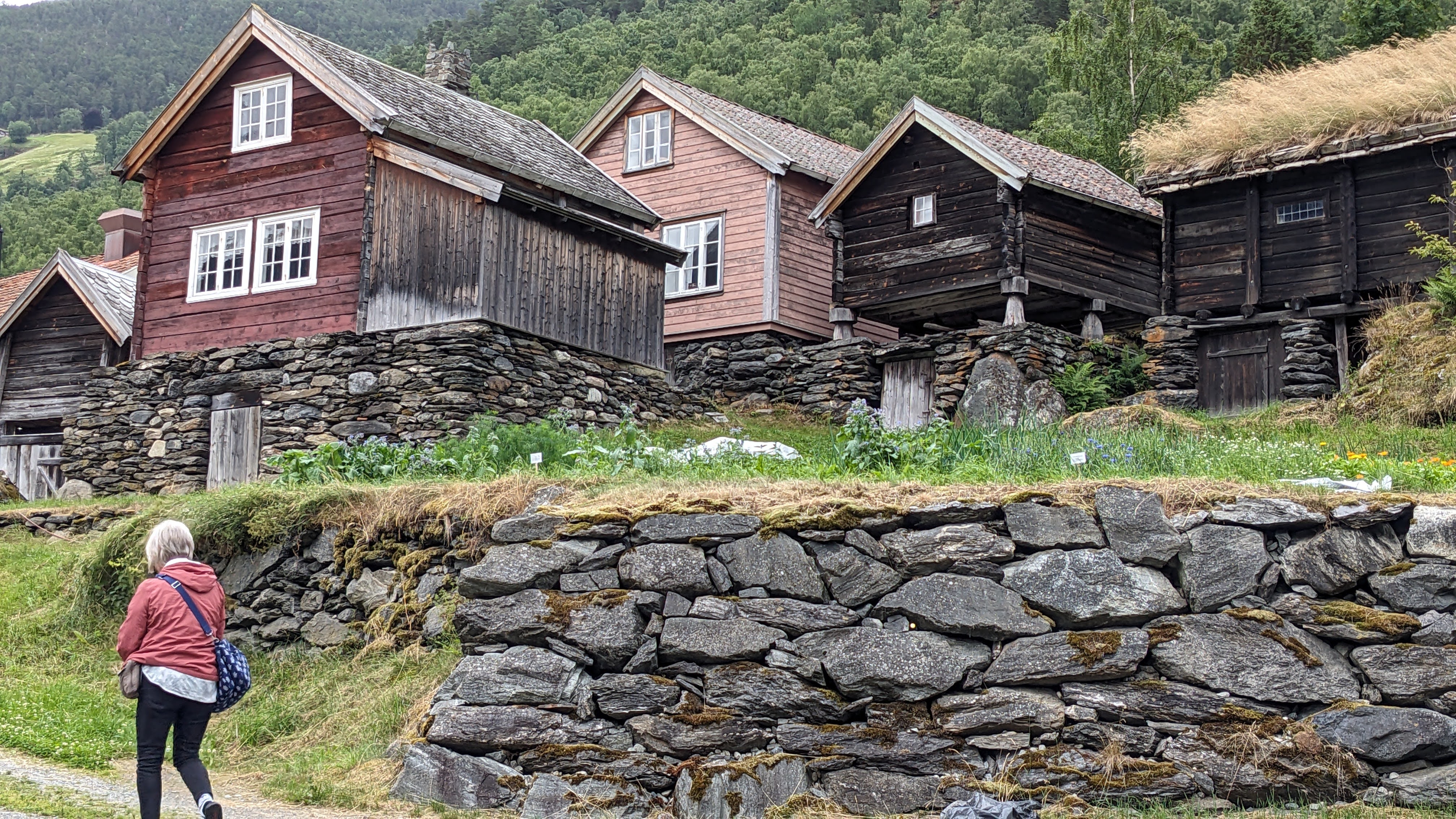 Pat on the road through Otternes Bygdetun |
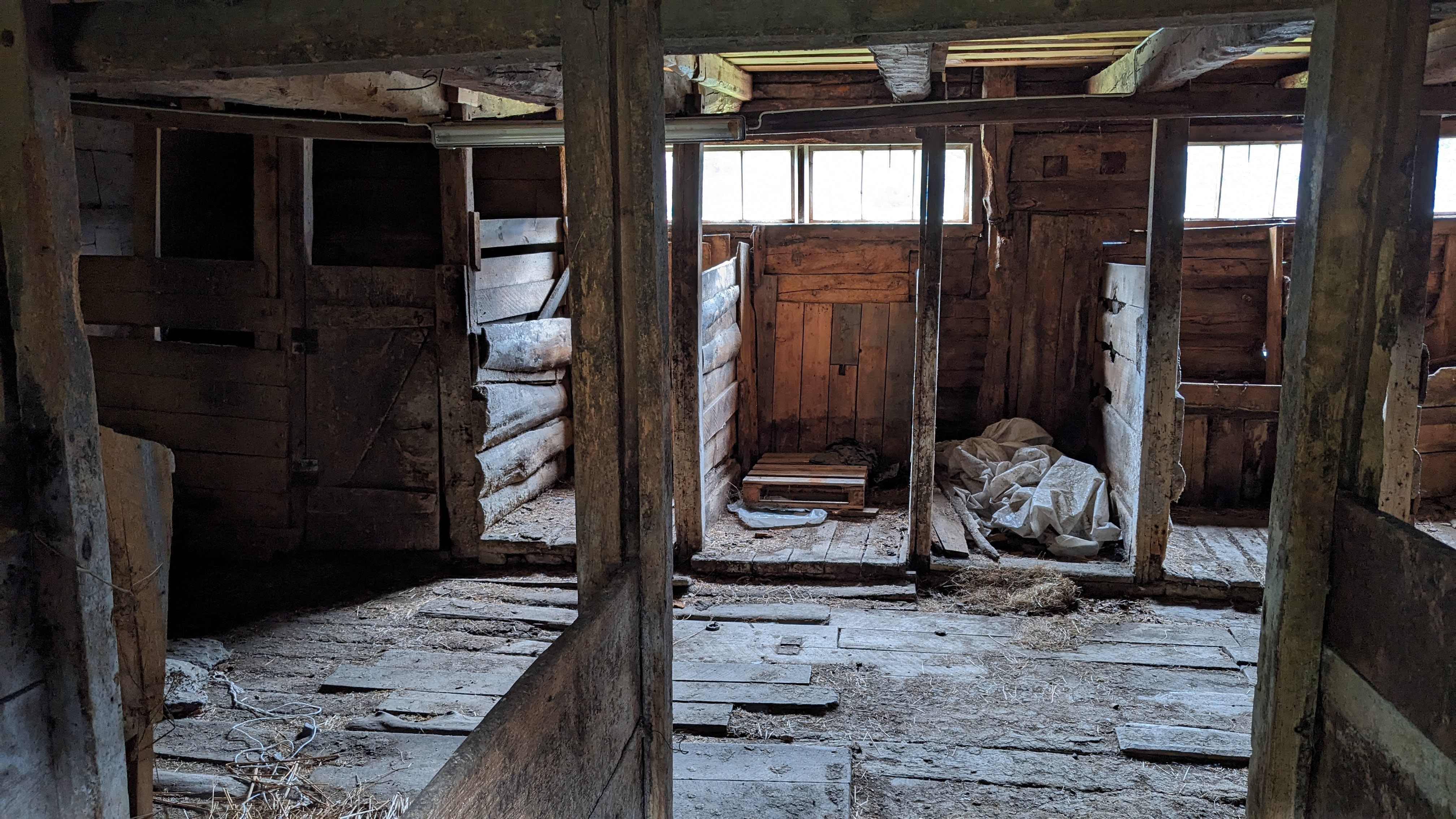 Inside an abandoned barn |
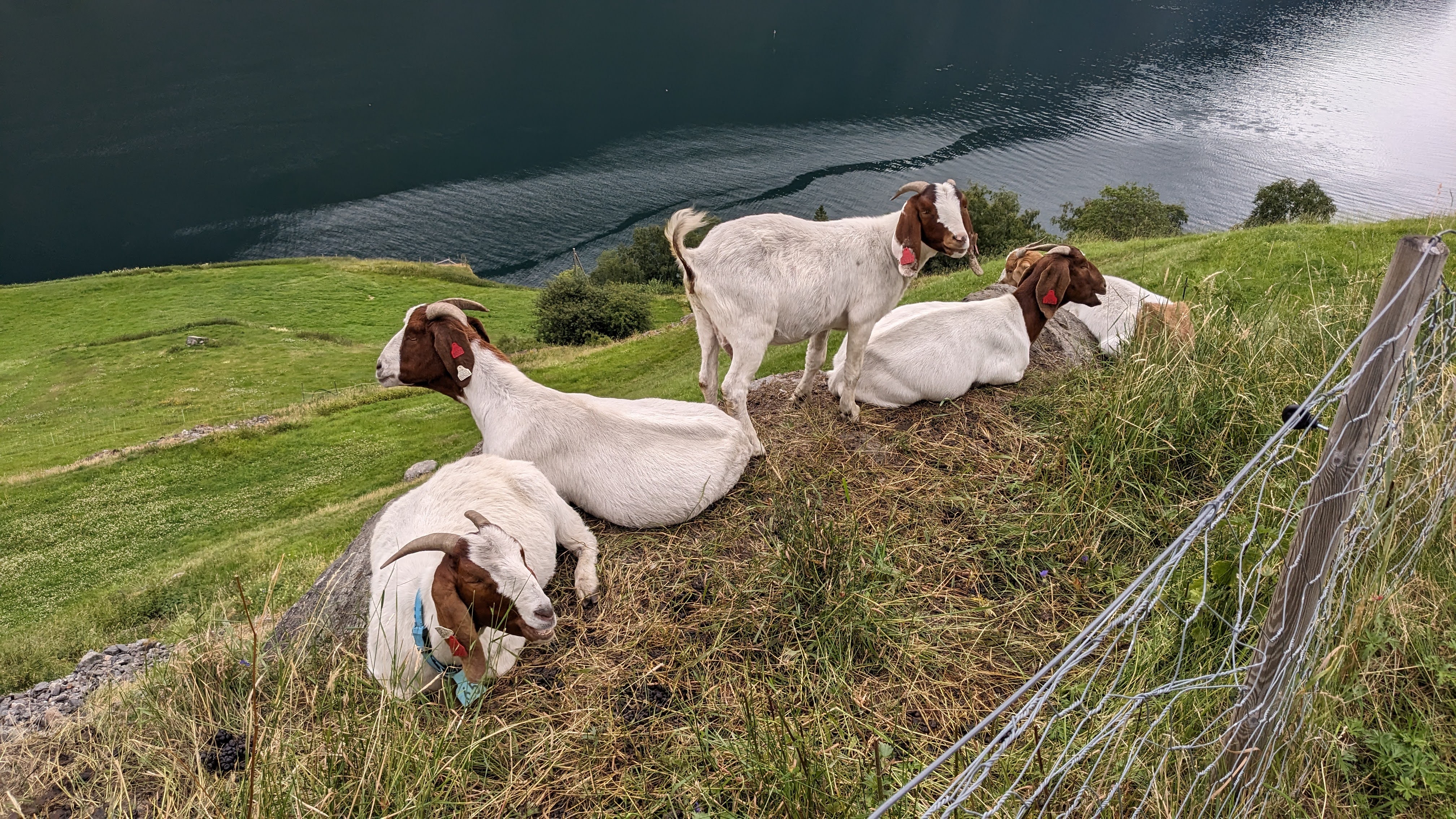 Goats taking the view for granted |
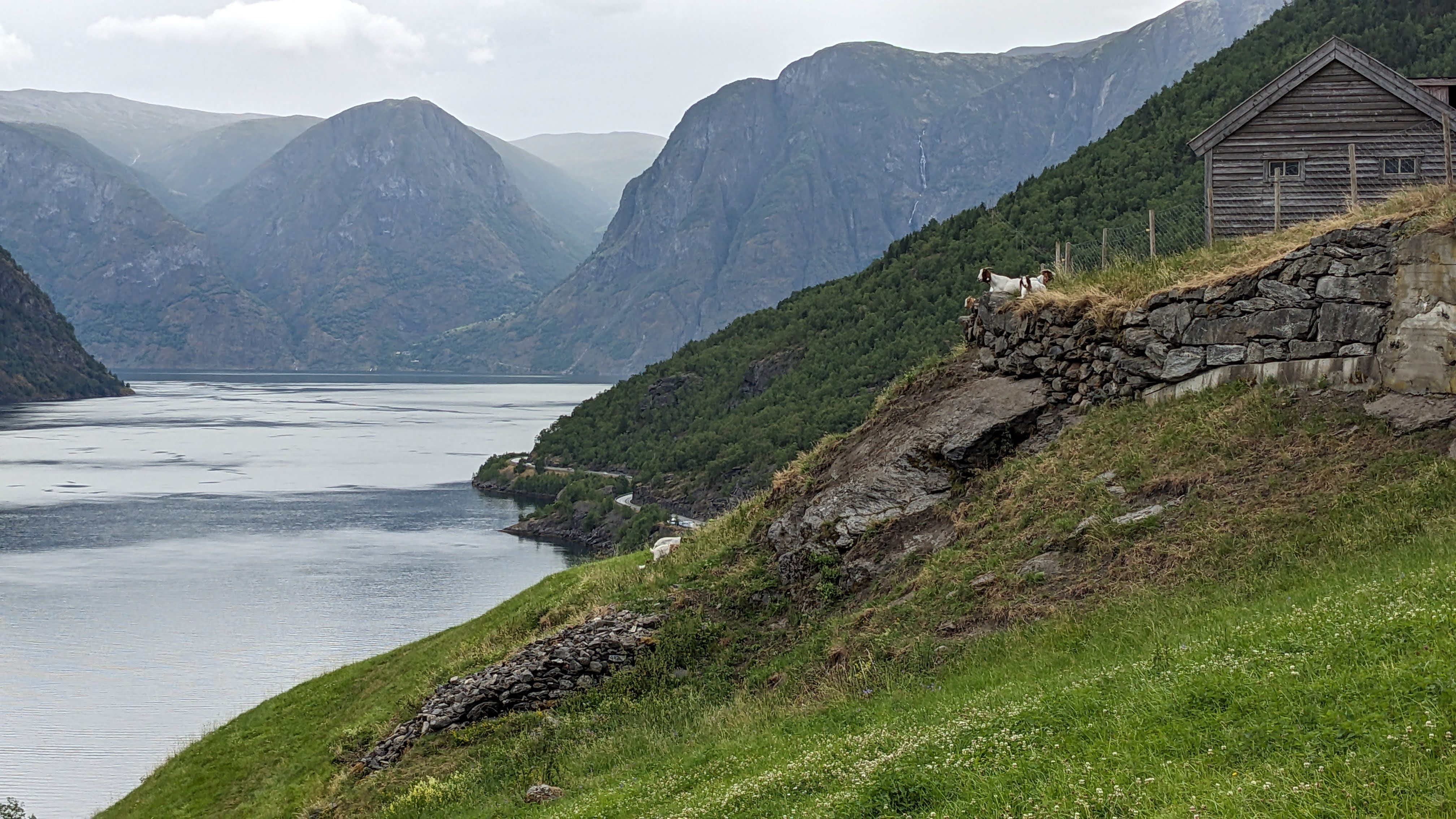 Otternes Bygdetun overlooks Aurlandsfjord … |
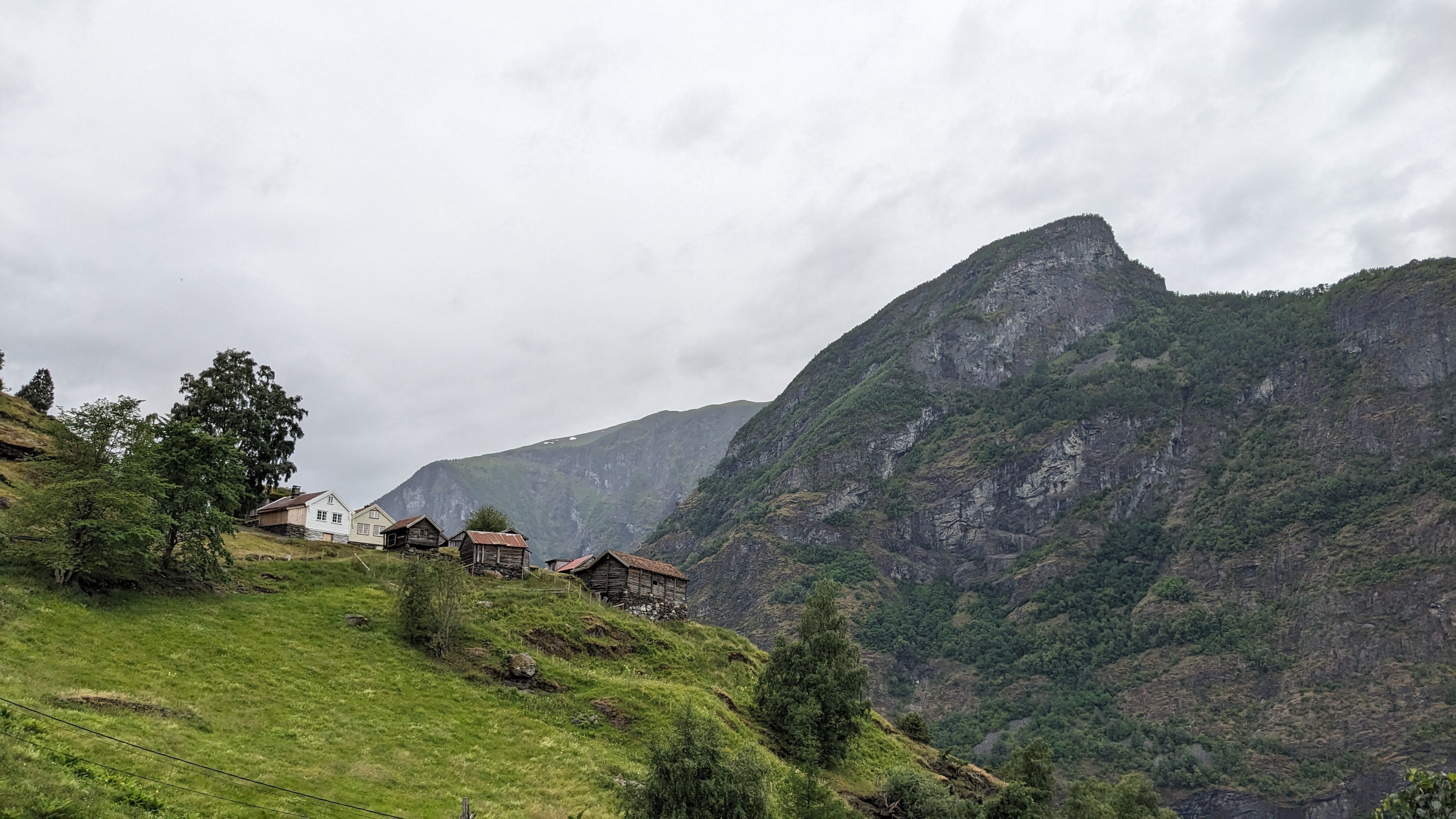 … and is overlooked by the peaks of Nærøyfjord World Heritage Park |
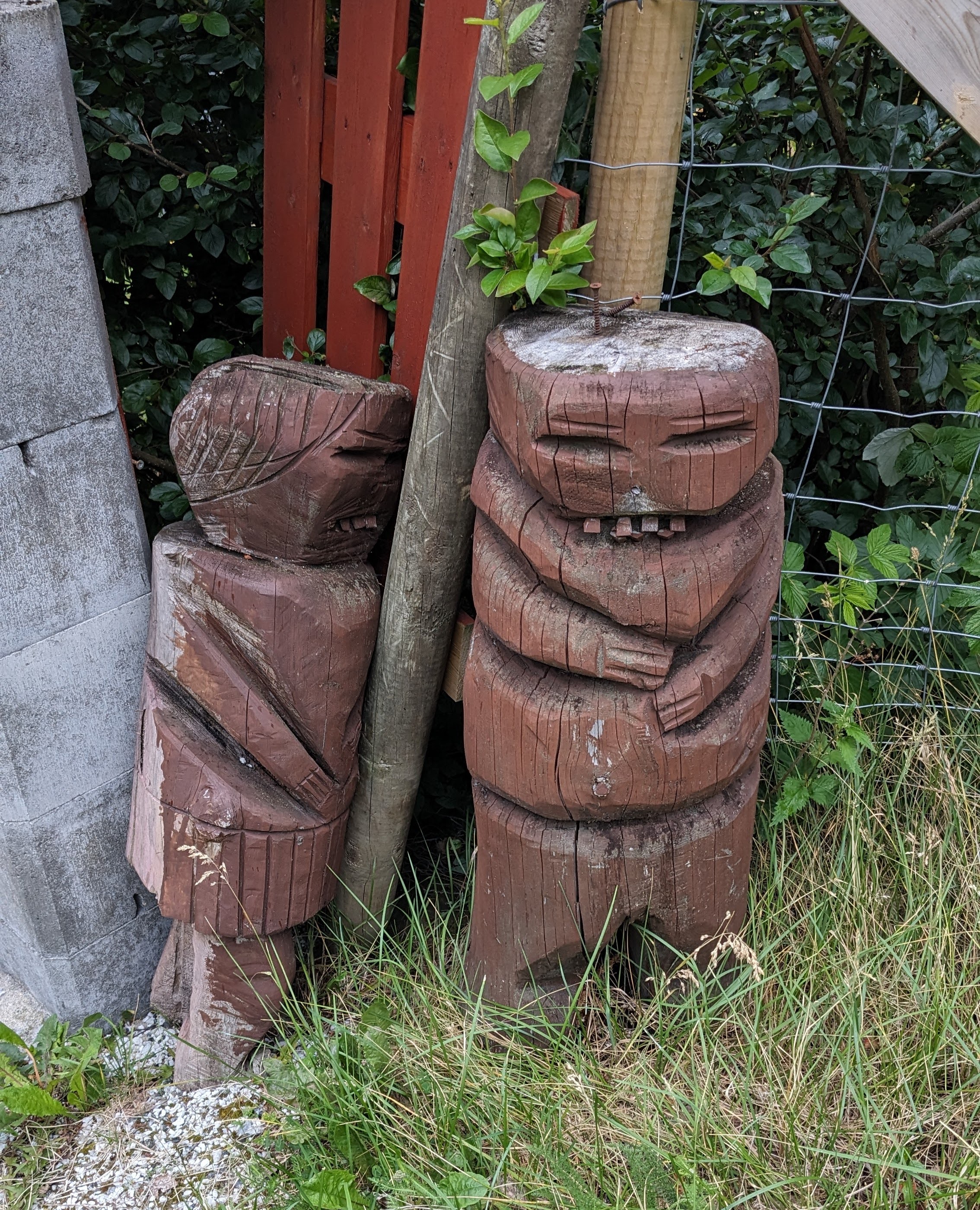 We spotted this pair of trolls at the end of a driveway down the hill from Otternes |
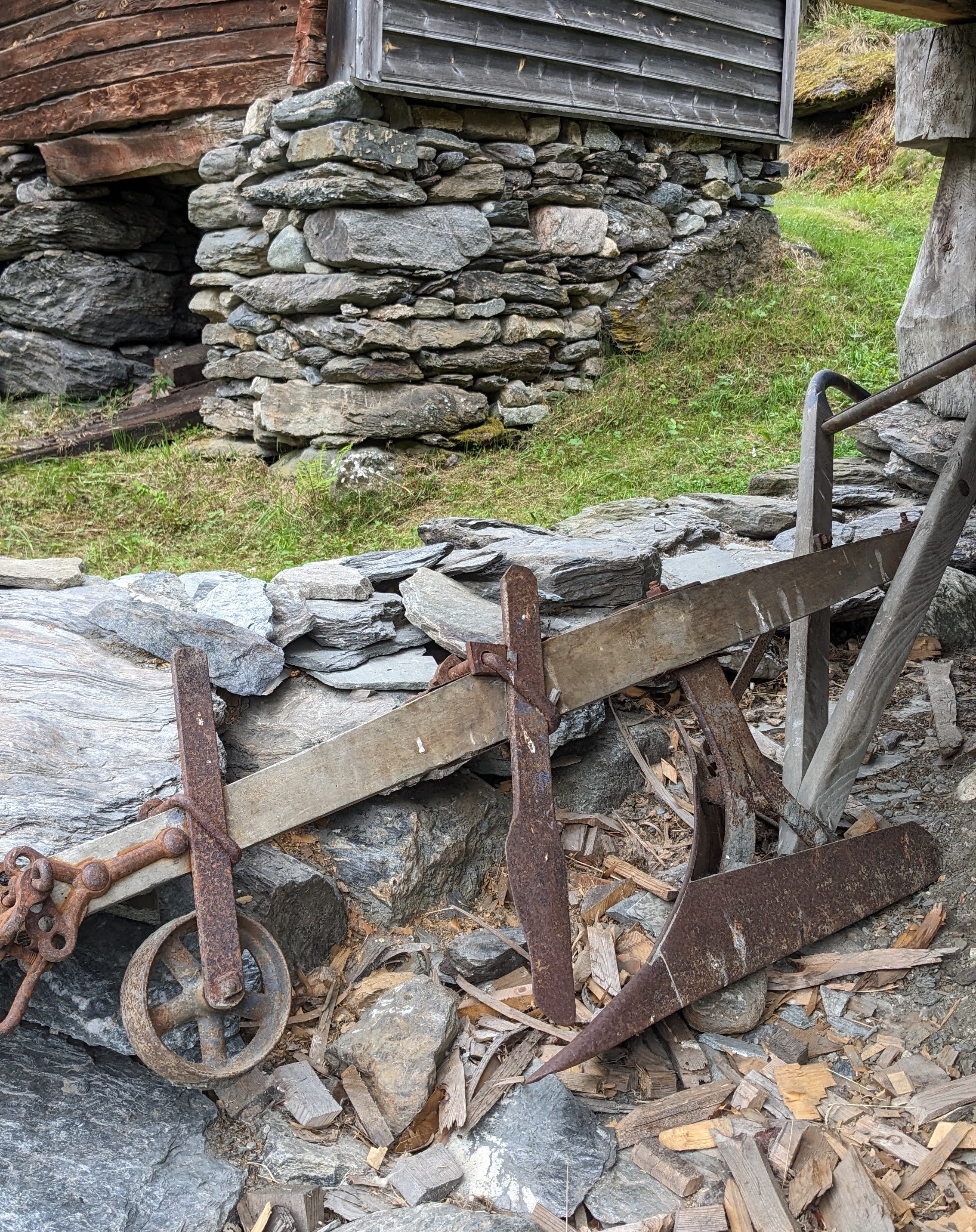 An antique plow in Otternes Bygdetun |
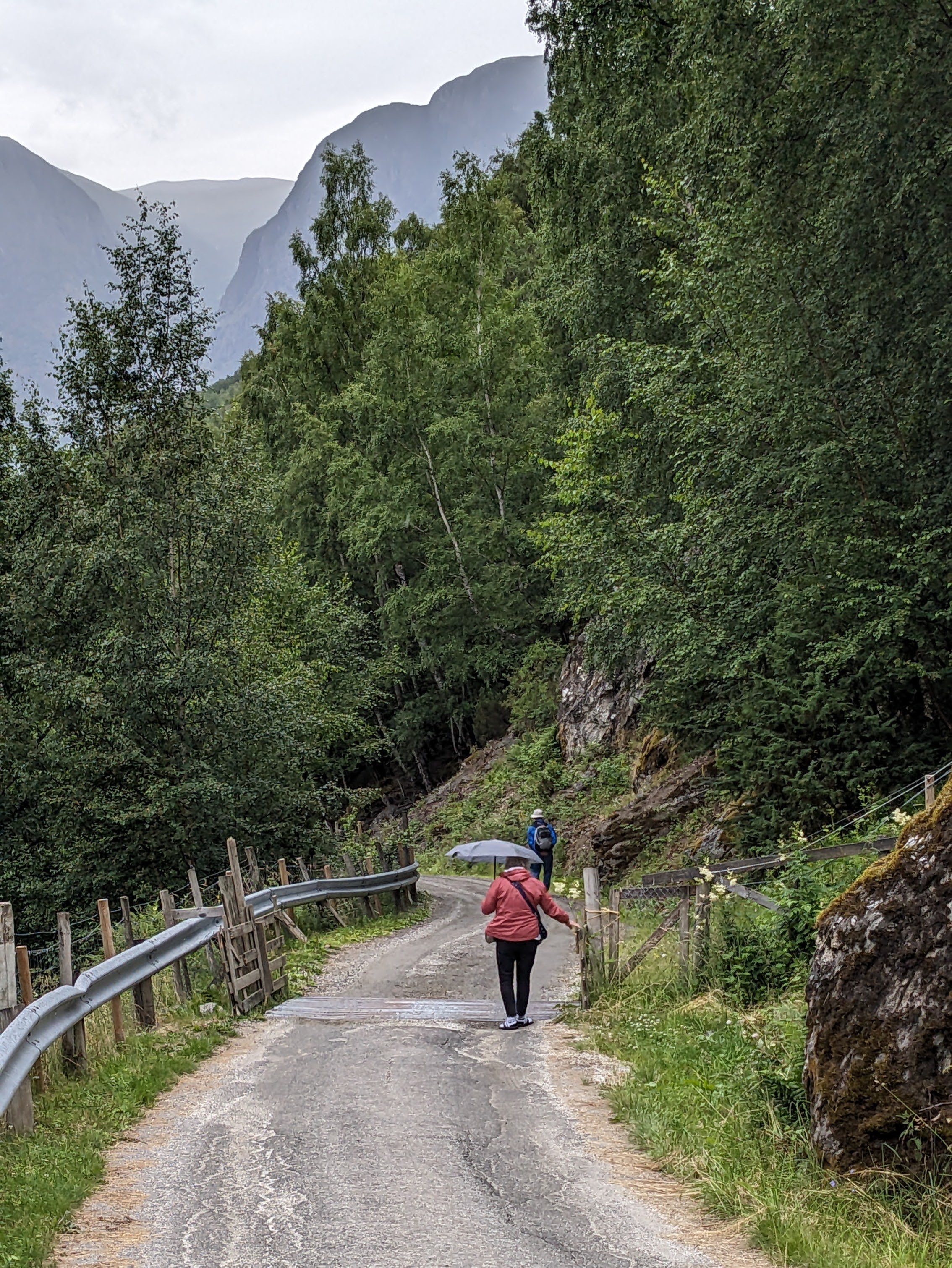 Pat heads down the hill from Otternes to the main road |
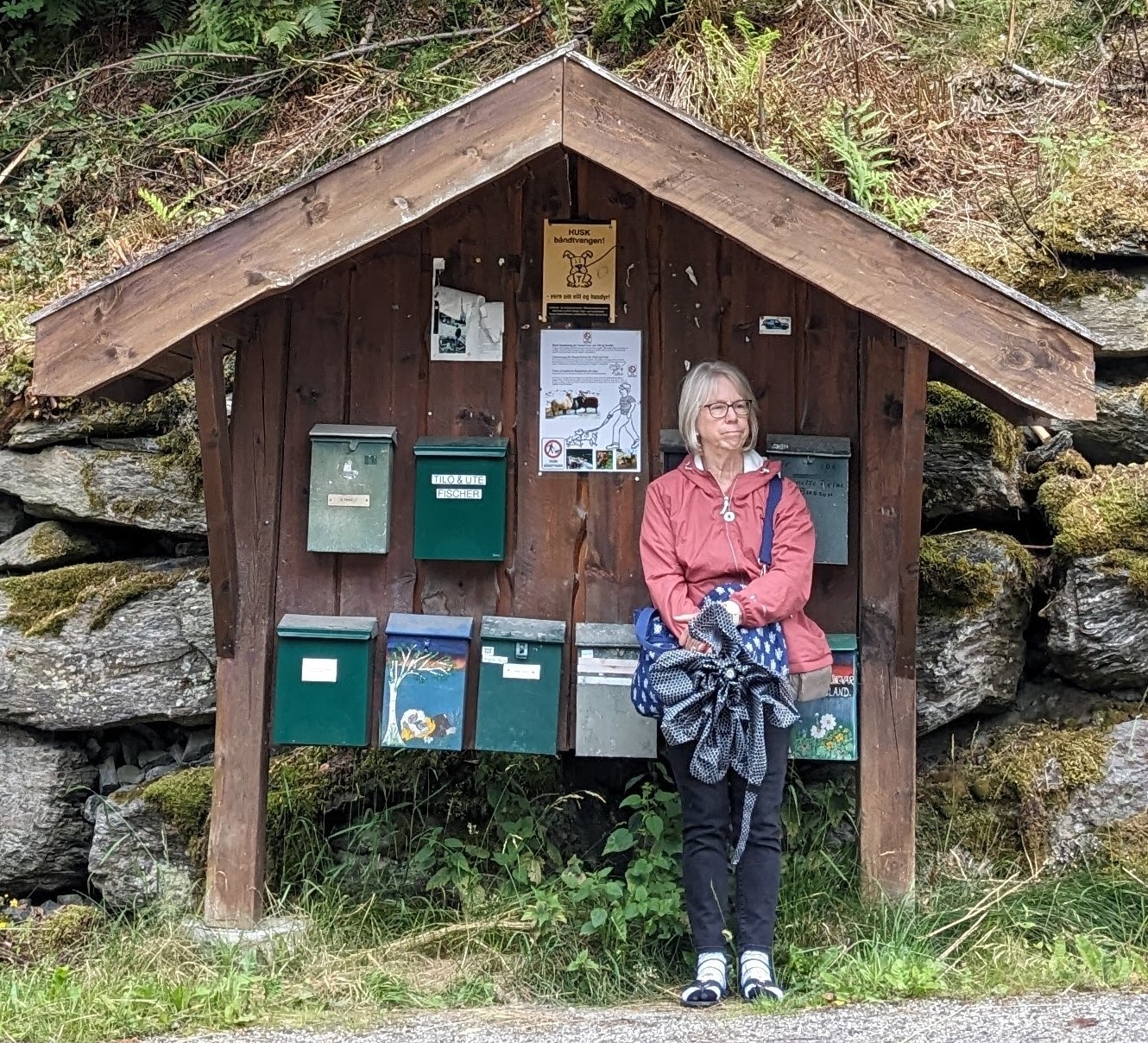
Pat waits patiently for the taxi to return
After about twenty minutes, Michael had seen enough and decided that we should head down the hill to the main road to wait for the taxi. Bored, and worried that the driver would never come back, Michael started devising alternative plans. We had not pre-paid for the return taxi trip, so the driver did have some incentive to come for us—but just in case, Michael decided to try hitchhiking. He actually stopped a passing car and asked for a ride, but the driver said he was not going to Flåm. Michael needn’t have been so anxious, however, because the taxi showed up precisely one hour from our drop-off time and got us back to the train station in plenty of time to catch the Flåmsbana to Myrdal.
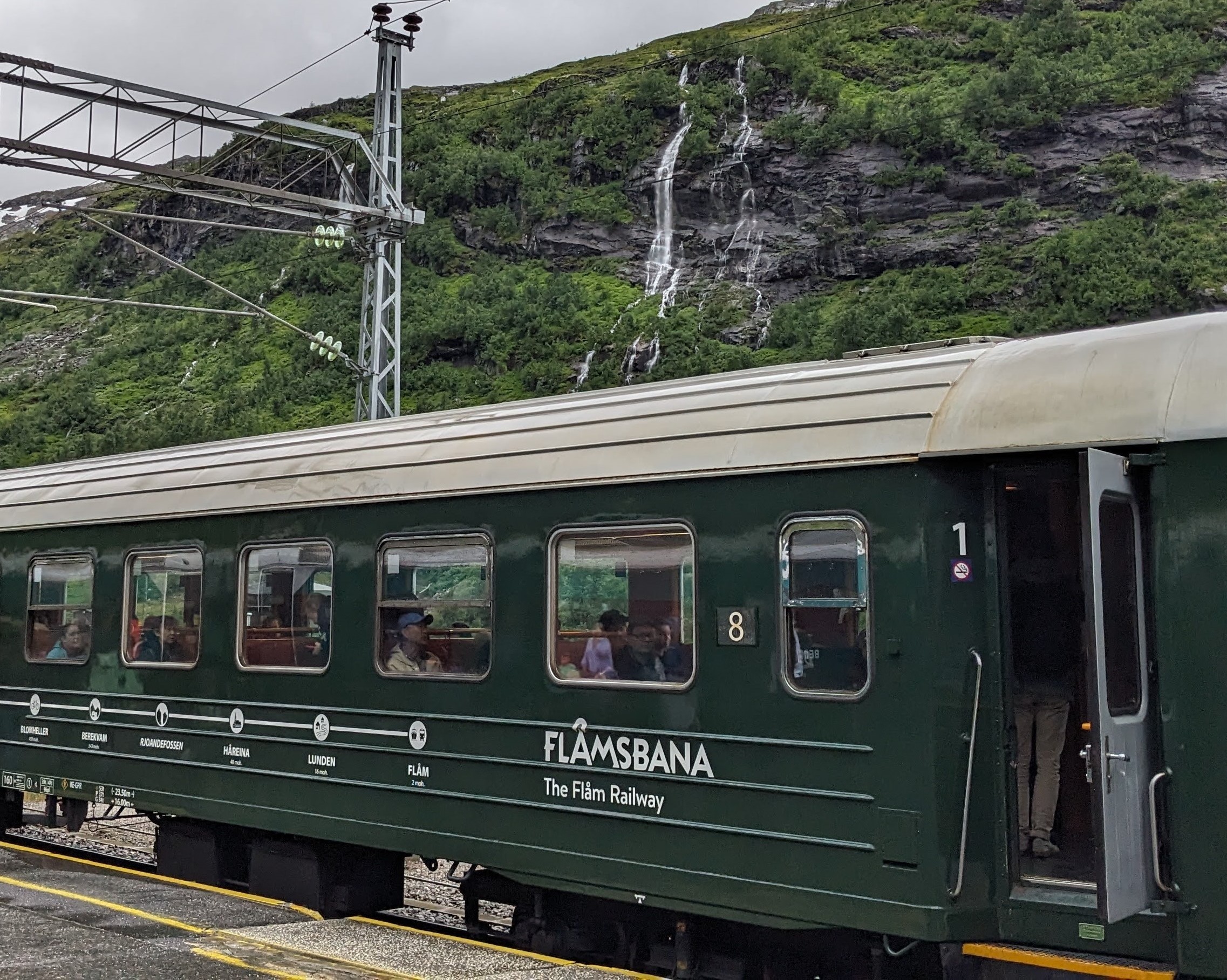
Flåmsbana train
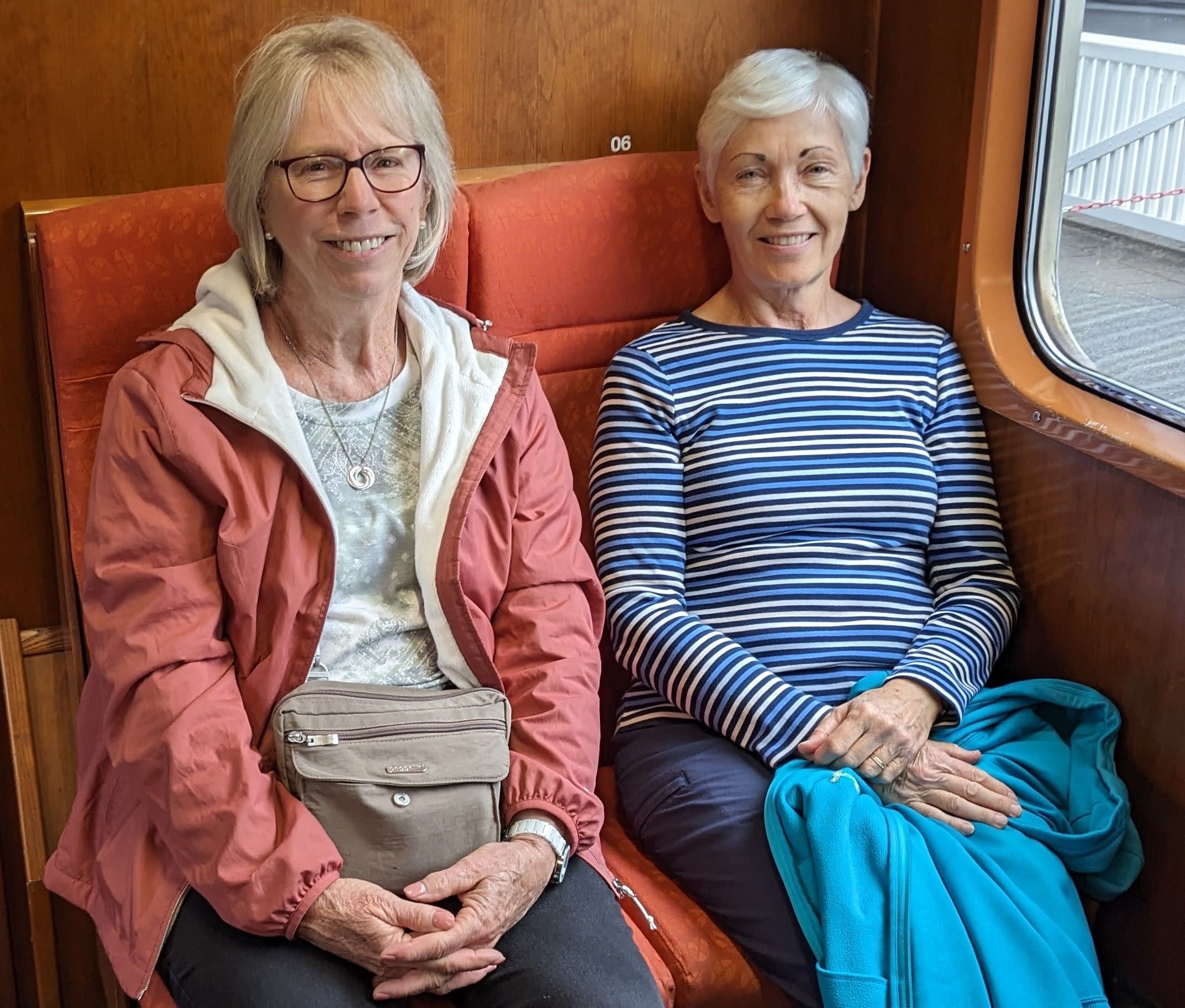
Pat and Nancy in the Flåmsbana train

The construction project included this windy road following the path of the Flåm River
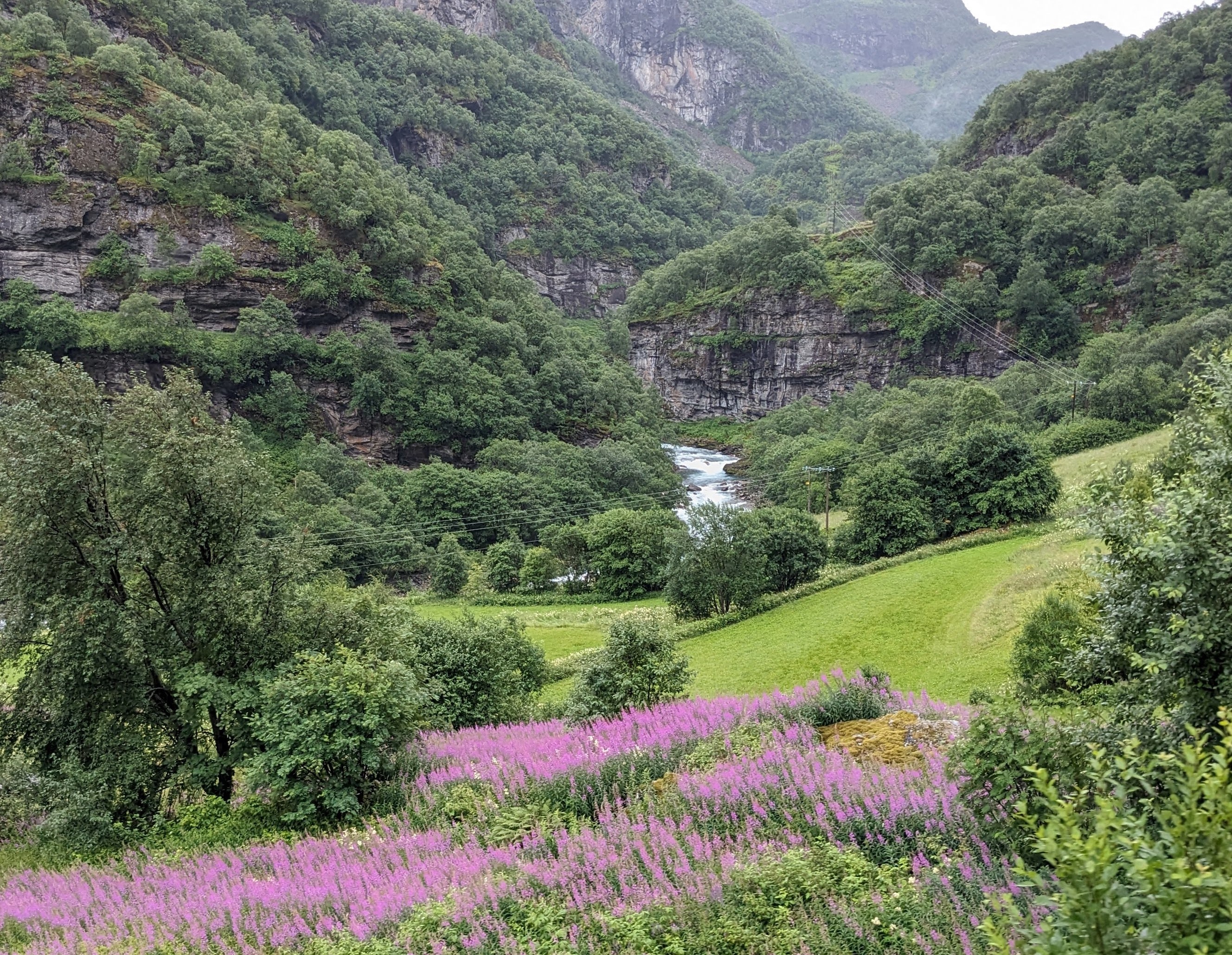
Lavender thrives in the high altitude
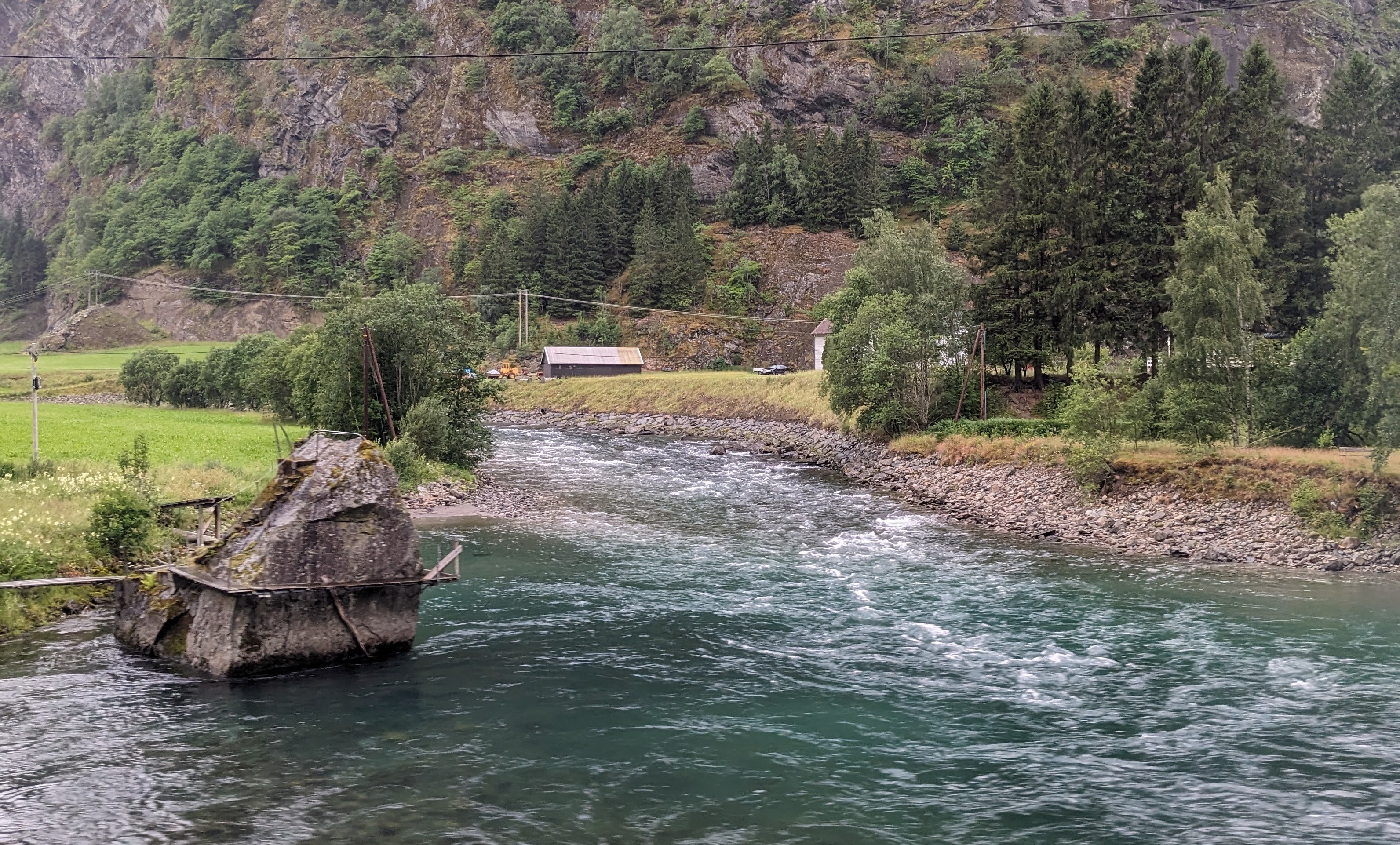
A deceptively calm spot in the Flåm River
We expected our one-hour trip on the Flåmsbana to be one of the scenic highlights of our Nutshell tour, and we were not disappointed. Only 20 kilometers (12.5 miles) long, the railway climbs from sea level at the Aurlandsfjord in Flåm to 287 meters (2845 feet) above sea level in the mountains at Myrdal, one of the steepest standard-gauge rail lines in the world. It passes over one bridge, under several snow roofs, and through twenty tunnels—all but two of which were drilled by hand during construction of the line in the 1920s and 30s. One of the tunnels takes a 180-degree turn within the mountain itself (which was kind of disconcerting for passengers; “Did we just turn around?” we wondered). This extraordinary feat of engineering took nearly twenty years and over six million man-hours to complete, and cost a number of lives (two directly during construction and many more from silicosis, a lung disease caused by inhaling mineral dust) but Norwegians are justly proud of the result.

Kjosfossen Falls
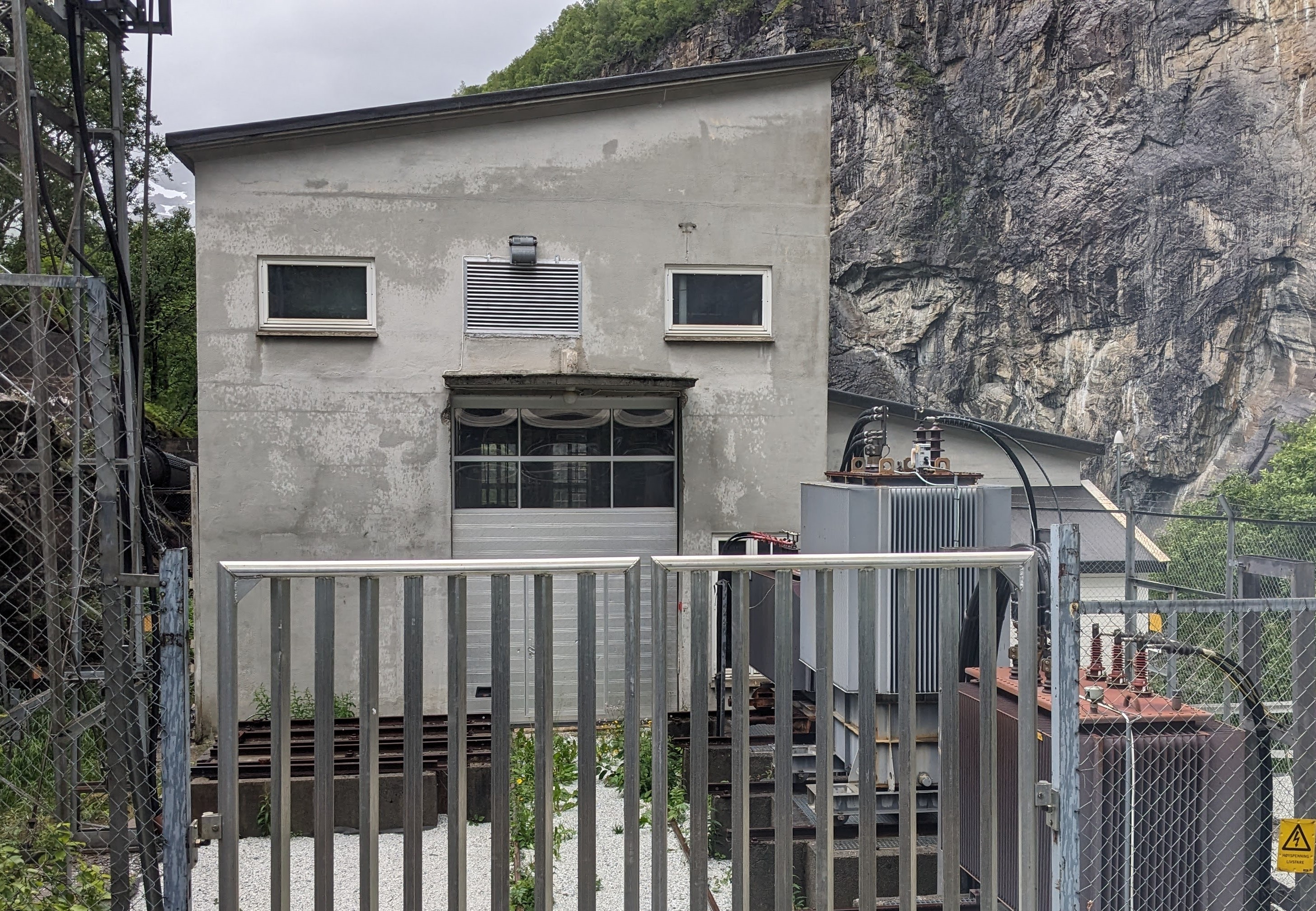
Generating station near Kjosfossen Falls
We saw countless waterfalls along our Flåmsbana journey, but the most dramatic was Kjosfossen Falls, where the train stopped and we were allowed out on a viewing platform for a few minutes. Water tumbles 225 meters (730 feet) from the top of the gorge, providing hydroelectric power for the railway.
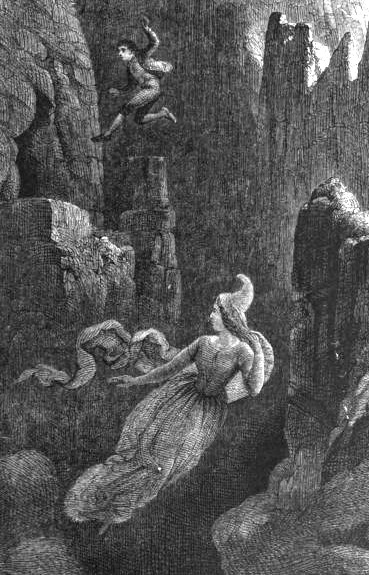
A seductive huldra lies in wait as a man leaps toward her cave
From the informative screen on the cruise ship, we had learned that Norway’s mountainous fjordlands are home to huldre (hidden folk, plural; the singular form is huldra), mythological creatures with qualities resembling those of both mermaids and woodland nymphs. Though described as beautiful, the all-female huldre are noted for having a distinctive inhuman feature, such as an animal’s tail (usually a cow’s or a fox’s), or a back resembling a hollowed-out tree. Like the Greek sirens that lured unwary seafarers into dangerous waters, huldre try to lure human men into marriage, because if they succeed, they lose their unsightly tails and hollow backs. However, forest workers and miners of centuries past reported that if treated with respect, huldre could be helpful. One might watch a woodsman’s charcoal kiln while he slept, for example, waking him if something went wrong, but the huldra would expect him to leave her food or other provisions in exchange. We later heard that huldre sometimes appeared to Flåmsbana passengers at Kjosfossen Falls (courtesy of students from the Norwegian National Ballet School) but we didn’t spot any during our whistle stop. Perhaps there were not enough single men onboard our train to coax them from their hiding places.
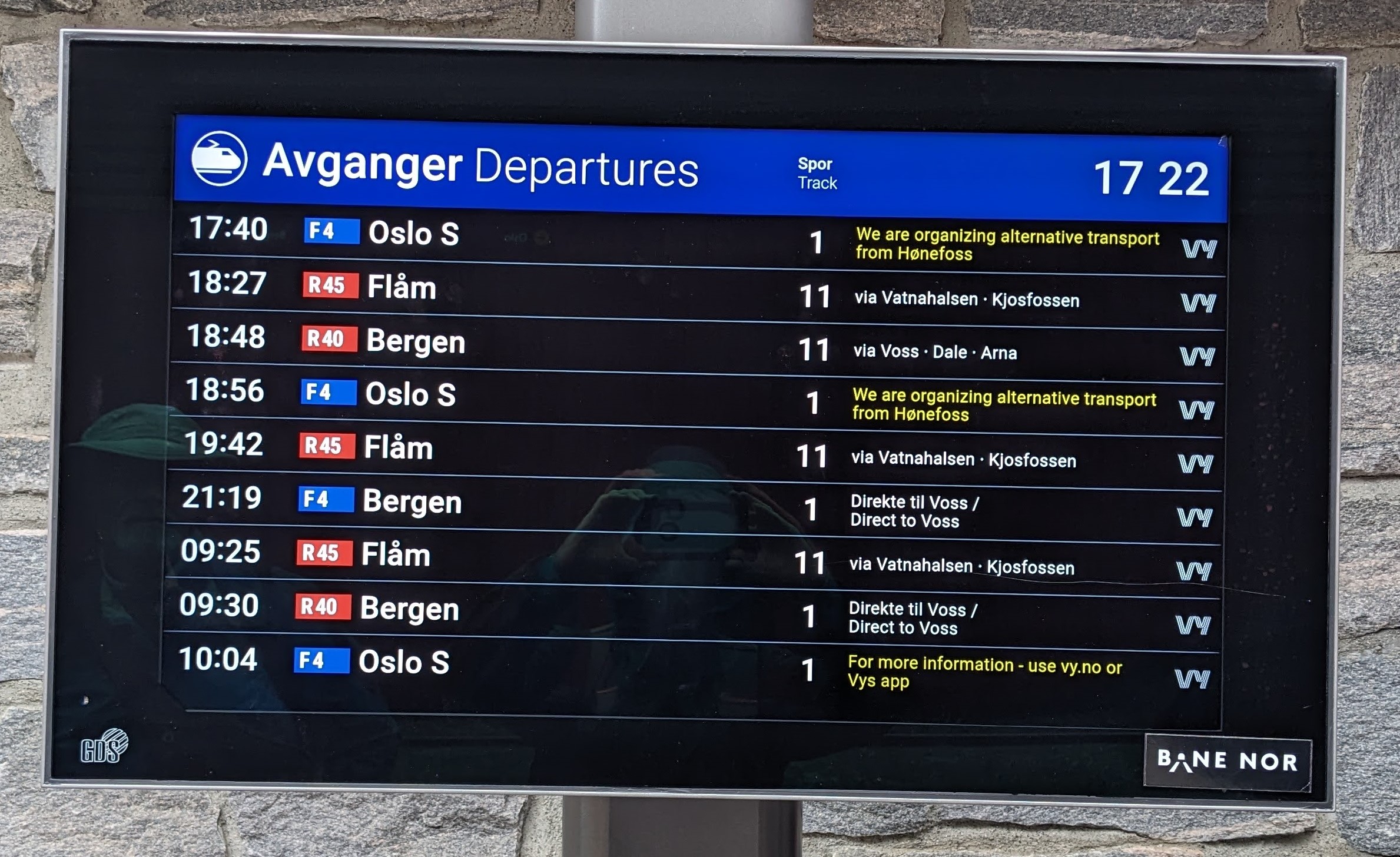
How would you interpret these messages if you were trying to get to Oslo?
We reached the end of the line in Myrdal a little after 5 p.m. From there, we were supposed to take the Bergensbanen back to Oslo for the final segment of our round-trip Norwegian adventure, but loudspeaker announcements we couldn’t quite catch seemed to indicate that there was a problem. Indeed, rumors were circulating among the scores of Oslo-bound passengers who had disembarked with us that there would be no more trains to the capital that night, and a cryptic message on the departures board next to every scheduled train to Oslo stated (in English): “We are organizing alternative transport from Hønefoss.”

Pat managed to find a place to sit while she ate her berry tart
Rain was falling, and all our fellow travelers were either trying to squeeze into a station house meant to accommodate only half as many or trying to find a spot under the roof overhang to keep from getting wet. Eventually we learned that the 65-kilometer (40-mile) stretch of rail line between Hønefoss and Oslo was closed for routine maintenance, so the Vy railway would provide bus transport for that last leg of our trip. That was a relief, but we still had an uncomfortable 40-minute wait before the train for Hønefoss arrived. Most people were buying drinks and snacks to pass the time, but we were among the last to reach the head of the line for food purchases, and it was nearly impossible even to find a place to stand and eat our pastries.

Nancy’s dinner
The station house quickly emptied out when the train to Oslo (or rather, to Hønefoss) finally arrived. Our tickets did not indicate any seat numbers so we just chose a place and sat down, but every time we tried to settle in, other passengers came up and showed us tickets indicating that we were occupying their seats. A kind steward explained that apparently we had not received the updated tickets Vy had issued that did include seat assignments, so he helped us find the right seats—but only after searching through a few cars for vacancies. Once we got underway, we took turns navigating through the train to the café car, where Michael got the last remaining spinach-and-chevre-filled pastry. Nancy’s menu choices were limited, but she was satisfied with the dinner special: meatballs served with lingonberry sauce, boiled potatoes, and “mushy peas.” (Really! That’s what they’re called: mushy peas!)
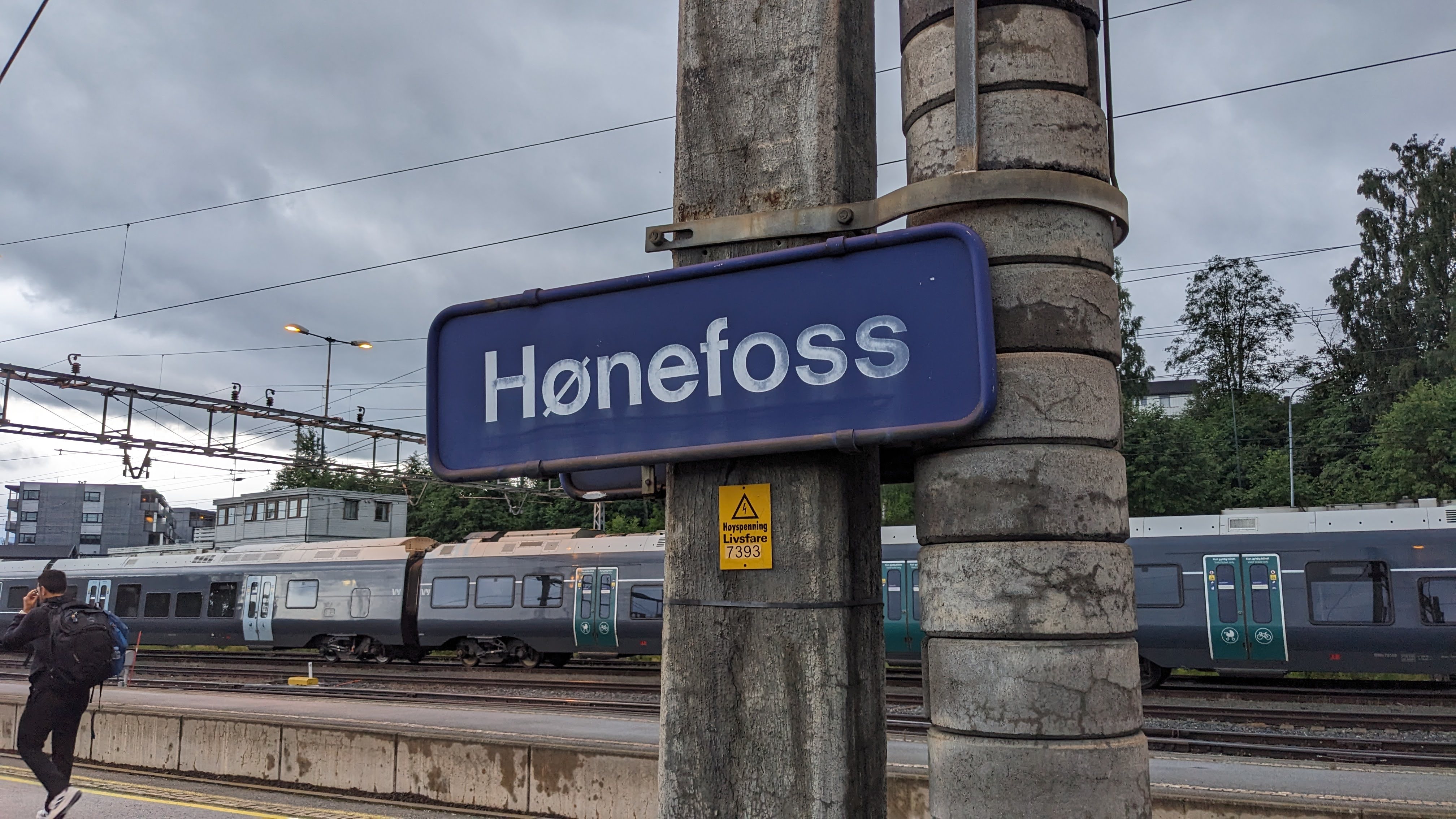
The end of the line—that night, anyway
At Hønefoss, everyone got off the train and boarded one of the six buses waiting for us. We had feared that the bus to Oslo would take longer than the train, but the bus pulled into the Oslo Sentralstasjon at about the same time the Bergensbanen would have. After retrieving the luggage we had stored in the station’s locker room, we walked back to the Citybox and by 9:30 p.m. had checked ourselves in again.
…the saga continues! Yes, mushy peas! They are the standard veg served with fish and chips in Jolly Old England. Waiting now to hear how the trip progresses. Thanks for sharing your adventures.
Spectacular scenery!